- 2024 Events
- Alcatraz Tours
- Attractions
- Family-Friendly
- Itineraries
- Things to Do
- Where to Eat
- Where to Stay
- SF Bay Area
- Cruises from SF
- All Beyond SF
- Northern California
- SF Arrivals and Transfers
- Weather & What to Wear
- Getting Around SF
- Earthquakes
- Games & Puzzles
SIGN UP FOR MY EMAIL TO RECEIVE YOUR FREE SAN FRANCISCO PLANNING GUIDE.

Fleet Week San Francisco 2024: Events, Blue Angels Shows & Pictures
by Jill Loeffler •
Fleet Week San Francisco is an annual event that draws thousands of people into the city.
It's a free event in the Fisherman's Wharf district that features the Blue Angels, a full air show over the SF Bay, and ship tours all weekend long.
This year, Fleet Week is October 7 - 15, 2024. Most activities and the large air show are over the weekend of October 11 - 13. You will find additional ship tours throughout the week.
I attend this event almost every year. The airshow is an amazing experience and I typically find myself at the waterfront all three days to watch it. I also try to tour one ship each year. The lines can be long, so be prepared for this if you plan to tour a ship.
My guide is based on my experience over the years and I hope it helps you make the most of this year's Fleet Week.
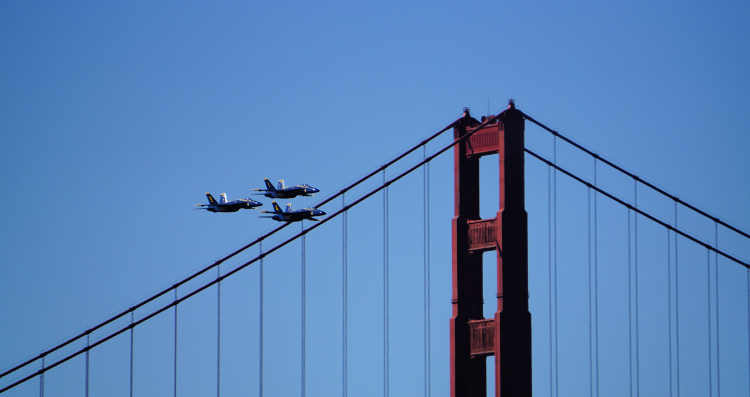
It began in 1981 to honor the US Armed Forces and to educate civilians and military personnel about best practices in humanitarian assistance. It's held every year in San Francisco on the first or second weekend in October.
The US Navy Blue Angels are set to perform on Friday, Saturday, and Sunday (October 11, 12, & 13) afternoon from 3 pm to 4 pm. They will usually do some practice runs on Thursday afternoon also.
Other air show performers include the Marine F-35B Demo, United 777, Ace Maker T 33, Patriots Jet Team, Coast Guard Dual Demo - Helos and C-27, Navy Parachute Team: The Leap Frogs, and more.
You can also enjoy the Parade of Ships on Friday or head out on a cruise to watch the Blue Angels perform from the water.
Disclaimer : I receive a small commission from some of the links on this page.
San Francisco Fleet Week Schedule 2024
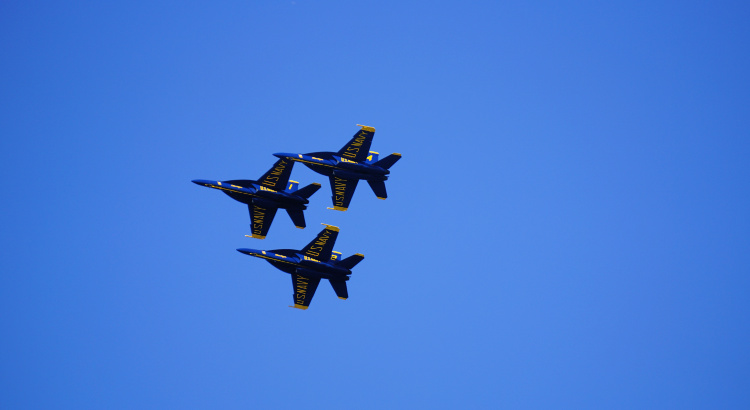
Almost all of the Fleet Week San Francisco activities are along the northern waterfront district of Fisherman's Wharf. This week's schedule of events includes the airshow featuring the Blue Angels, ship tours, live music and other entertainment all weekend long.
Here is the schedule for 2024. Some of this is still TBD, so I'll continue to add in more details as they are announced.
Monday, October 7
Tuesday, October 8
Wednesday, October 9
Thursday, October 10
Friday, October 11
- 10 am to 5 pm: Humanitarian Assistance Village
- 11:00 am - 12:00 pm: Parade of Ships
- 12 pm - 4 pm: Air Show (Blue Angels: ~3 pm - 4 pm, arrive early as they will sometimes start as early as 2:45 pm )
Saturday, October 12
- 10 am to 2 pm: K9 Heroes at Duboce Park
- 12 pm - 4 pm: Air Show (Blue Angels: ~3 pm - 4 pm, arrive early as they will sometimes start as early as 2:45 pm)
Sunday, October 13
- 10 am to 4 pm: Humanitarian Assistance Village
- 12 pm - 4 pm: Air Show (Blue Angels: ~3 pm - 4 pm, arrive early as they will sometimes start as early as 2:45 pm)
Monday, October 14
- 10 am to 3 pm: High School Band Challenge at the Golden Gate Park Bandshell
Tuesday, October 15
*Schedule of events is subject to change at anytime.
Cruises During Fleet Week San Francisco
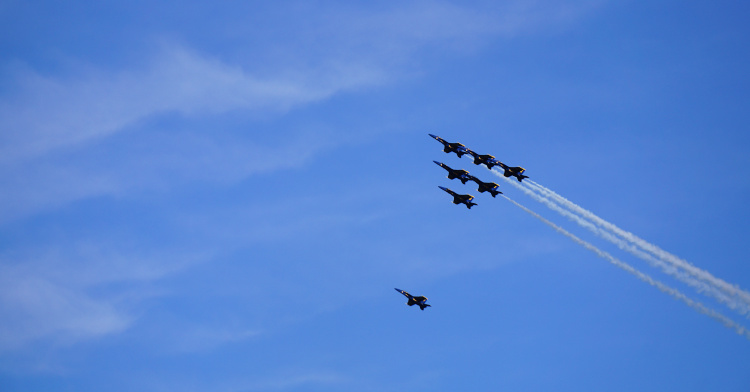
One of the best ways to watch the Blue Angels fly over the San Francisco Bay is from a special Fleet Week cruise. These sell out quickly, so I recommend booking your cruise as soon as you have your plans finalized.
Red & White Fleet 2.5-Hour Fleet Week Cruise
- 2-hour afternoon cruise to see the Blue Angels over San Francisco
- Offered Friday (10/11), Saturday (10/12), and Sunday (10/13) of Fleet Week
- Cruise leaves at 1:45 pm (please arrive at least 30 minutes before departure)
- Outdoor decks with incredible views of the performance
- Beverages and light snacks available for purchase at the cash bar
- Leaves from Pier 43 1/2 in Fisherman's Wharf
- $105 for Adults (21+ and includes two drinks), $65 for Youth (5-20), free for those under 5, but they must have tickets to manage capacity on the boat
- Visit their site for ticketing details
Cruise on the SS Jeremiah O'Brien
- Saturday, October 12 and Sunday, October 13 from 10 am to 5 pm (boards at 9 am)
- Cruise around the bay in the morning and get front row seats for the air show in the afternoon
- Catch the air show from 12:30 pm to 4 pm (with the Blue Angels performing from 3 pm to 4 pm)
- Complimentary food and drink, coffee and donuts when you board; hot dog lunch with soft drinks, water, beer and wine
- Tickets are $185 for adults (age 17+) and $110 for children (age 5-16)
- There is also a $500 family group option for up to 2 adults and 2 youth
- Find out more and book your seats for 2024
Blue & Gold 2.5-Hour Cruise
- Saturday (10/12) and Sunday (10/13), One boat per day leaving at 1:30 pm and returning at 4 pm, boarding time starts at 1:15 pm, but they ask that you arrive 45 minutes in advance
- Tickets include a box lunch from Boudin Bakery (sandwich, chips, and cookie)
- Alcoholic beverages and soft drinks available for purchase at their on board bar
- Tickets start at $105 for adults, $70 for children, $85 for seniors and military members, free for those under 5
- Find tickets on their site
Fleet Week Cruise with Hornblower
Dates: Friday, Saturday, & Sunday
Time: Boarding at 1:30 pm, cruising from 2:30 pm - 4:30 pm
Boarding Location: Pier 3 Hornblower Landing
- 2-hour lunch cruise on the SF Bay
- Buffet includes entrees, salads, and desserts
- Free flowing sparkling wine, coffee, orange juice, water, and soft drinks
- Purchase wine, beer, and cocktails throughout the cruise
Additional Activities : Are you looking for some additional fun activities for your visit? Check out my list of the best things to do in October . You will also find a lot of free attractions and activities this month all around SF .
Best Places to Watch the Air Show & the Blue Angels
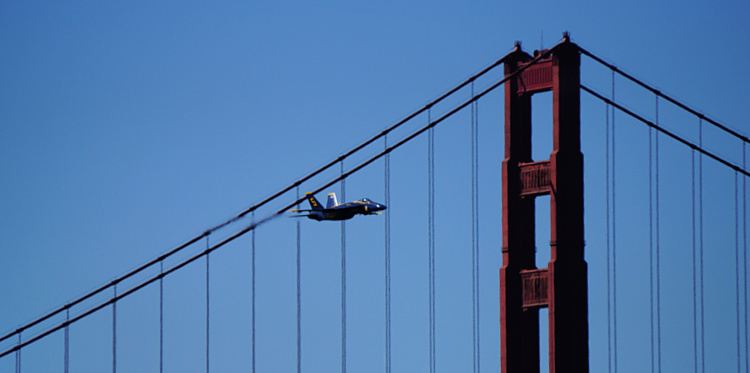
The northern side of San Francisco along the bay is CROWDED during the air show. If you want to sit down, you will need to arrive at least an hour before the Blue Angels perform.
Most of the Air Show takes place over the bay, around Fisherman's Wharf and Fort Mason .
Here are a few places to watch the Air Show with some additional notes to think about for each option:
You will be close to the action, but it gets really crowded here.
However, it's a great place to see most of the show.
Try to find a spot with a clear view of the Golden Gate Bridge .
Aquatic Park
There is a small stadium here with seats facing out over the bay. You will get a great view of the Fleet Week San Francisco Air Show from here, although the maneuvers over the Golden Gate Bridge will be harder to see.
Crissy Field
There will be fewer people on this side, which makes it a nicer viewing area.
This is a great place to see the Blue Angels maneuvers near the bridge.
It is a little further away from the main action though, so the trees may block out a little bit of the show.
Marina Green
Just to the east of Crissy Field is the Marina Green. This large green space offers a great look at the air show.
You can also buy premium tickets for this area so you don't have to fight for a place to watch the fun.
Tickets for the premium section are already on sale.
You will find them on the official Fleet Week website .
Additional Places to See the Blue Angels in SF
Here are a few places to see the Blue Angels at this year's Fleet Week San Francisco. You won't get great views of the entire airshow, but you will get some great views of the Blue Angels over San Francisco and the Bay.
Golden Gate Bridge Walkways : You can also see the airshow from the walkways of the Golden Gate Bridge. The eastern walkways are open during the airshow, but they fill up early. I would arrive at least a couple of hours in advance of the start of the airshow in order to get a good spot to see the entire show.
Twin Peaks : You can also see the Blue Angels during Fleet Week San Francisco from Twin Peaks . You won't get a close up view, but some good views of the Blue Angels.
Marin Headlands : Another great place is the Marin Headlands. You will see the airshow, but the biggest benefit to this location is being able to see the Blue Angels near the Golden Gate Bridge.
Again, these are not the best spots for the Fleet Week San Francisco airshow, but some alternative to watching it from the shore along Fisherman's Wharf.
More Things to Do this Weekend in San Francisco
These are some of the other fun things to do during Fleet Week San Francisco or as you are waiting for the big airshow to begin.
San Francisco Theater
Catch a theater performance during your time in San Francisco. Every year, the Golden Gate and Orpheum Theaters welcome hit Broadway musicals.
This year, you will find Wicked on stage throughout Fleet Week. Find tickets .
In addition, smaller theater companies perform at a variety of venues all over town.
>> Find a full list of theater performances this weekend in San Francisco
Free Walking Tours
Every day of the week, SF City Guides offers free walking tours in different districts all over town. Learn more about the Golden Gate Bridge, Union Square, the Palace of Fine Arts, and more.
>> More details on SF's free walking tours
Concerts in San Francisco
If you love to listen to live music, then you will find plenty of options this weekend in SF. We have venues large and small with everything from well known artists to popular local bands.
>> Click here for a full schedule of concerts this weekend
Additional Fun Tours to Check Out
Hotels for san francisco fleet week.
Since more than a million people attend Fleet Week San Francisco each year, I highly recommend booking your hotels early.
Note : Most hotels will not guarantee that you will get a waterfront room to see the show from your room. Plus, you won't get great views of most of the show so I recommend heading outside to watch it.
All events are in Fisherman's Wharf and it's a great place to stay. You can easily walk to and from your hotel to see the shows and enjoy all of the activities.
Here are a few recommendations in this San Francisco neighborhood.
Courtyard by Marriott : 3-star hotel, 2 blocks from the waterfront, next door to In-N-Out Burger, 580 Beach Street, read recent guest reviews and get your room
Marriott Fisherman's Wharf : 3.5-star hotel, 2.5 to 3 blocks to the waterfront, great for those also visiting North Beach , 1250 Columbus Street, read recent reviews and book your room here
Hotel Zoe : 4-star hotel, 3 blocks to the waterfront, steps away from the Powell/Mason cable car turnaround , 425 North Point Street, read reviews from recent guests here
Find additional hotel recommendations for Fisherman's Wharf .
Fleet Week San Francisco Ship Tours (TBD for 2024)
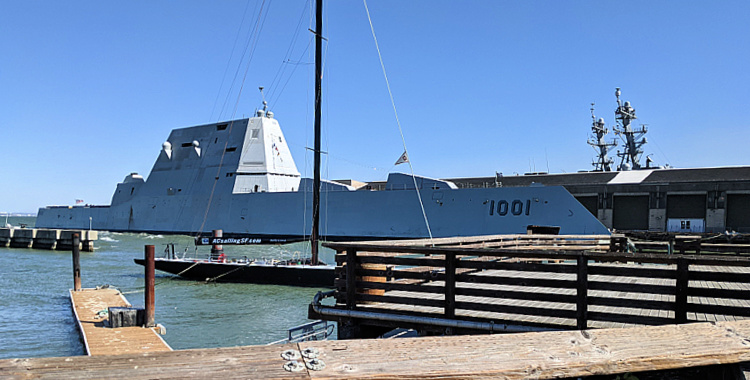
The Fleet Week San Francisco ship tours are wildly popular. All tours are free, and they encourage you to interact with the sailors on board. I recommend showing up well before they open their doors, as it's first come, first served and the lines get long fast.
These are all the ship tours from last year, 2023. I will update this when they announce the ships that will be here for 2024. Due to national security reasons, they only announce these about three or four days before the ships arrive. However, this is a good estimate on what you can expect again this year.
Tuesday, Wednesday & Thursday (from 2023)
- 10 am to 4 pm on Tuesday and Thursday, 10 am to 2 pm on Wednesday
- SF Pier 30/32 only
Saturday and Sunday (from 2023)
- 10 am to 4 pm
- SF Pier 30/32 and Pier 35
Monday (from 2023)
- 9 am to 12 pm
These are the ships that were on site in 2023. I'll also update this once the ships are announced, which is usually right before they arrive.
- Amphibious transport dock USS John P. Murtha (LPD-26)
- Guided missile destroyer USS Paul Hamilton (DDG-60)
More Rules to Visit the Ships During Fleet Week
- Must show a valid government ID if you are 18 and over
- Anyone 17 and under must be accompanied by an adult
- No large backpacks, large purses, or large camera bags
- May not be accessible for those with disabilities or certain medical conditions. Most ship visits require climbing steep steps, uneven surfaces, small areas, etc.
- No high heels and closed toed shoes are recommended.
- Must remain with your tour guide at all times while on the ship.
- Must comply to screening and inspection before boarding each ship for your tour.
More Pictures and What to Expect in 2024
Below are a few of my photos from previous years for each activity. They will give you an idea of what to expect this year.
Parade of Ships 2024: Friday, October 11 from 11:00 am to 12:00 pm
The Parade of Ships is the official start of the Fleet Week San Francisco celebrations. All of the ships for the event come in under the Golden Gate Bridge and head to their designated pier in San Francisco. You can tour all of these ships during the three-day celebration.
A couple of years ago, my mom, sister, and I were on Alcatraz Island during the Parade of Ships, which is one of the best places to be for this event. Here are just some of my pictures from that day.
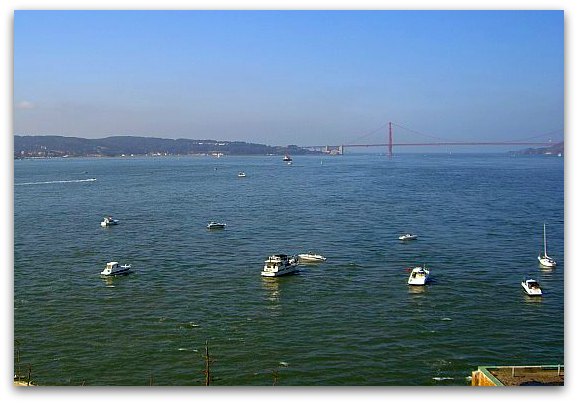
The Parade of Ships is about ready to begin. The boats at the bottom of the picture are all waiting for the parade to start. In the background is the Golden Gate Bridge, which is where all the boats enter the San Francisco Bay for the event.
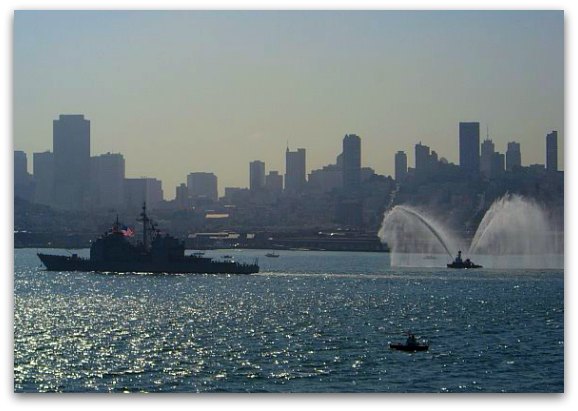
This is one of the first boats coming in for Fleet Week San Francisco. You can see the downtown San Francisco skyline in the background.
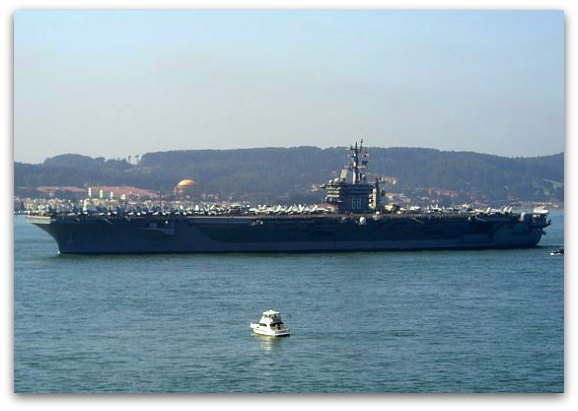
This is one of the largest ships that come into San Francisco for Fleet Week. It's an aircraft carrier and is open for tours all weekend. In the background are the Presidio and the Palace of Fine Arts .
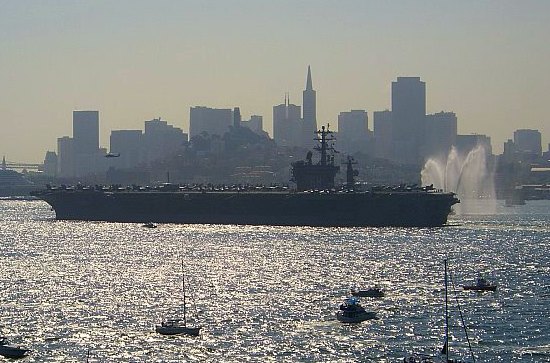
This is a second look at the aircraft carrier heading into San Francisco. It's close to Alcatraz Island and making its way to its pier to set up for tours. You can again see downtown San Francisco including the Transamerica building in the background.
Fleet Week San Francisco Air Show: Friday, Saturday & Sunday
The event that most people come out for is the air show on Friday, Saturday and Sunday from 12 pm to 4 pm. There are several performances during the four-hour show.
All three days, the air show finishes with an amazing performance by the Blue Angels. They always start their performance a little after 3 pm. Even if you have watched them before, you will never get tired of seeing their performance over the San Francisco Bay.
Here are just a few of my Blue Angels photos from previous Fleet Week San Francisco performances. This is a shot of just four of the six Blue Angels doing a maneuver. This is another shot from Pier 39.
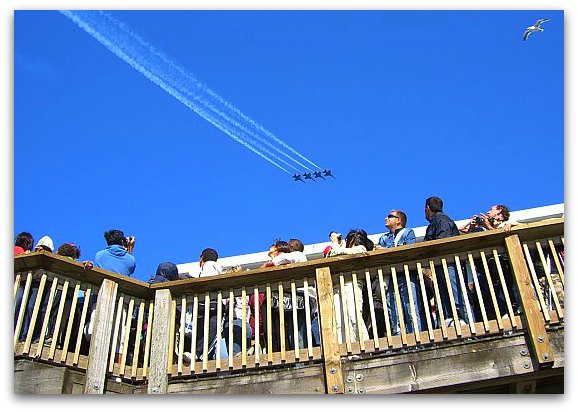
This is another shot of the Blue Angels, in the distance, performing over the San Francisco Bay. In front is a crowd of people and the sea lions near Pier 39.
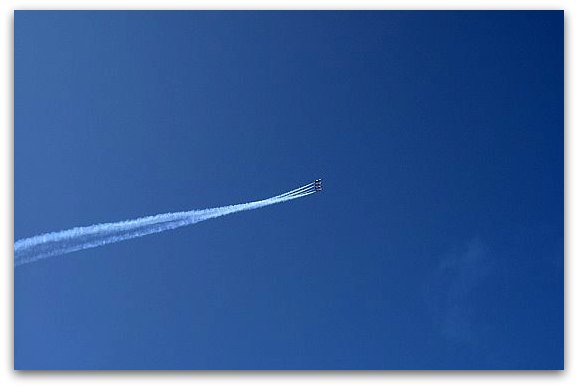
The smoke trailing the Blue Angels as they perform another maneuver.
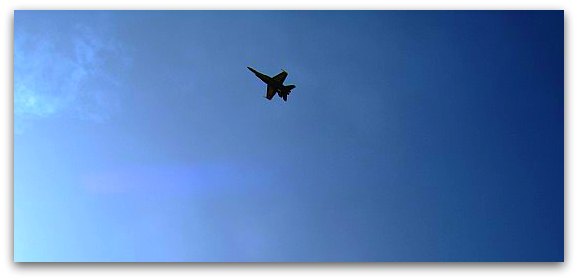
The Blue Angels get daringly close during their performance. My camera does not have a great zoom, so this shows just how close you will feel from the viewing area!
You can also head out to catch some of the practice session on Thursday. There are fewer people around and they don't perform their entire show.
However, it's a great way to catch the action if you are not going to be around on Friday, Saturday or Sunday.
Fleet Week Free Concert Series (TBD for 2024)
Here is a full schedule of all free concerts for 2023. You'll find them both along the waterfront and also in neighborhoods throughout San Francisco.
Monday, October 2
- Sunset Library, 12:30 pm, Navy Band Southwest, Woodwind Quintet
Tuesday, October 3
- Warriors Thrive City, 12 pm, 1st Marine Division Band
- City College Ocean Campus, 12 pm, Navy Band Southwest - Brass Band
- San Francisco Zoo, 12 pm, Navy Band Southwest - Woodwind Quintet
- Salesforce Park, 1:30 pm, 1st Marine Division Band - Brass Band
- Noe Valley Town Square, 6 pm, 1st Marine Division Band - Brass Band
Wednesday, October 4
- Hayes Valley, Patricia's Green, 12 pm, 1st Marine Division Band, Ceremonial Band
- Crab Wheel Plaza at Fisherman's Wharf, 12 pm, Navy Band Southwest - Destroyers
- San Francisco VA Medical Center, 12:30 pm, Navy Band Southwest - Woodwind Quintet
- One Sansome, 5 pm, Navy Band Southwest - Woodwind Quintet
- Japantown Peace Plaza, 5:30 pm, Navy Band Southwest, Brass Band
Thursday, October 5
- Ferry Building Marketplace, 12 pm, Navy Band Southwest, Woodwind Quintet
- Presidio Visitor Center, 3 pm, US Air Force - Band of the Golden West
- Castro in the Jane Warner Plaza, 5 pm, Navy Band Southwest, Brass Band
- Herbst Theatre, SF War Memorial & Performing Arts Center, 6 pm, Honor Our Fallen Concert - 1st Marine Division Ceremonial Band and Navy Woodwind Quartet
Friday, October 6
- Golden Gate Park Band Shell, Noon, Navy Band Southwest, Brass Band
- Cable Car Turnaround at Powell/Market, Noon, 1st Marine Division Band, Brass Band
- Union Square Plaza, 12:30 pm, 1st Marine Division Band
- Lakeside Landing, 4 pm, Navy Band Southwest - Woodwind Quintet
- Pier 39, 5 pm, Navy Band Southwest - Destroyers
- Valencia Street (btw 16 St-17 St), 6 pm, 1st Marine Division Band, Ceremonial Band
Saturday, October 7
- K9 Heroes at Duboce Park, 10 am, 1st Marine Division Band - Ceremonial Band
- Polk and Jackson Streets, 12 pm, 1st Marine Division Band - Brass Band
- Ghirardelli Square, 12 pm, Navy Band Southwest - Brass Band
- Chinatown (Grant Ave & Commercial St), 12 pm, Navy Band Southwest, Woodwind Quintet
- Pier 39, 12 pm, Navy Band Southwest - Destroyers
- West Portal Courtyard (82 West Portal Ave), 4 pm, 1st Marine Division Band, Brass Band
- Westwood (2036 Lombard Street), 7 pm, 1st Marine Division Band, Diamondbacks
Sunday, October 8
- Jefferson & Powell to Washington Park, 11:00 am, Marine and Navy Band Southwests
Monday, October 9
- Golden Gate Band Shell, 10 am, High School Band Challenge
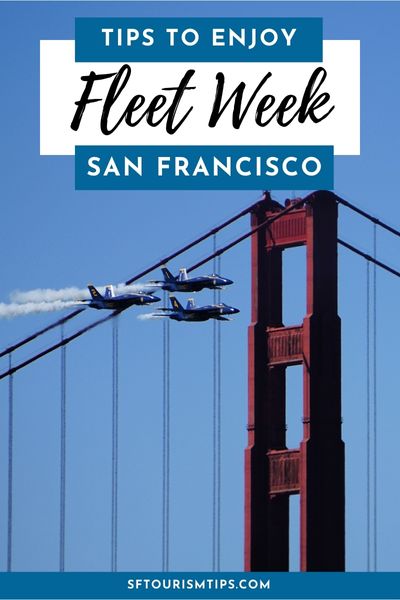
Comments? Questions? Suggestions?
I would love for you to join me in my private Facebook group !
It's a great place to interact with me and others who know the area well.
You can ask questions, get advice for your upcoming stay, and then share your photos and advice with others when you return home. It's a great community and the fastest way to get answers to those nagging questions about your visit!
Come join the fun here !
About Me | Contact Me | Privacy Policy | Terms of Service | Advertising Disclaimer
As an Amazon Associate I earn from qualifying purchases.
Exclusive Member of Mediavine Travel
Copyright © 2009-2024 by SFTourismTips.com. All rights reserved.
This website does not sell any personal information. (See privacy policy )
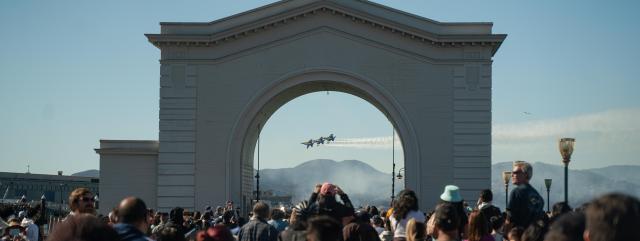
- Locations : Pier 35 near Fisherman's Wharf, and Piers 30/32 between the Ferry Building and the Giants ballpark.
- Cost : Free, queues are first come, first served - read Fleet Week Shipboard Guidelines
Nearby restaurants and shops:
- Queen's Louisiana Po-Boys - Pier 33
- EPIC Steak - Rincon Park
- Waterbar Restaurant - Rincon Park
- Hi Dive - Pier 28
- Red's Java House - Pier 30
Parade of Ships
- Date : Friday 10/6
- Location : Between the Golden Gate Bridge and Bay Bridge
- Cost : Free
The procession will move across the waterfront towards the Bay Bridge, and any clear bayfront area is an ideal viewpoint to see the parade. Areas with unobstructed views include the apron at Pier 45, Pier 41 walkway, the Pier 39 boardwalk, the Pier 27 Cruise Terminal and walkways at Piers 15, 7, 1 and 14.
- Pier 23 Cafe - Pier 23
- Coqueta - Pier 7
- La Mar - Pier 3
- Ferry Building Marketplace
Fleet Week Air Show
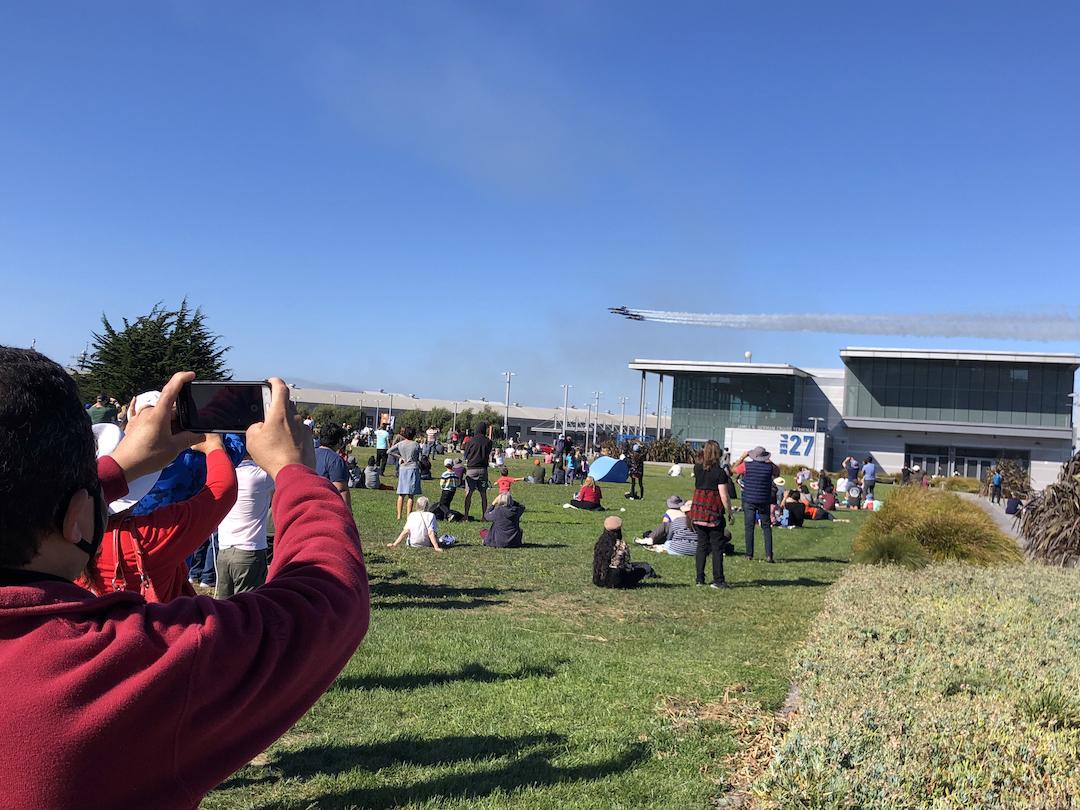
- Date: Friday 10/6, Saturday 10/7, and Sunday 10/8
- Location : Between the Golden Gate Bridge and Alcatraz
The waterfront event is headlined by the Blue Angels and is the only air show in the US with a commercial airliner, the United 777, to perform a fully choreographed act.
Ticketed seats in Marina Green may be purchased on the Fleet Week website. Open spaces on the waterfront often fill early and quickly. It is recommended to arrive early to find your ideal viewing spot.
The air show may be too loud for dogs. People with sensitivities to noise may benefit from earplugs or ear covers.
- Fisherman's Wharf
- ABC7 Bay Area 24/7 live stream Watch Now
- Watch the latest ABC7 newscast here Full Story
- ABC7 proud new home of SF Chinese New Year Parade Full Story
- Track wildfires across CA with this interactive map Full Story
Fleet Week: Military ships open for tours in San Francisco

SAN FRANCISCO (KGO) -- The US Navy opened three ships to the public Wednesday morning in San Francisco for Fleet Week.
The USS Monsoor and the USS Shoup are docked at Pier 35. The USS Rushmore is at Piers 30/32. The USS McCain is also docked at Pier 35 but is not open to the general public.
"We love showing off our ship, we are all proud of it," said Ensign Scarlett Siemans aboard the USS Shoup Wednesday morning.
Military officials have cut back on how much interior space visitors will see because of COVID. Places like the mess hall and the living quarters will be closed. But crew members onboard say they believe the highlights of the tour are located outside and are still on the tour.
"I would definitely say the wide array of weapon capabilities we have. The destroyer is the big bad ship of the Navy, getting to be right next to it is pretty special," said Ens. Jack Dale.
The ships are open from 10 a.m. to 4 p.m. Wednesday, Thursday, Saturday and Sunday. Friday they are closed because they will participate in the parade of ships. Monday they are open from 9 a.m. to noon.
SCHEDULE: SF Fleet Week 2021 returns with Navy's Blue Angels air show, military ships & more
Related Topics
- SAN FRANCISCO
- BAY AREA EVENTS

SF Fleet Week 2023 schedule of events

Blue Angels impress thousands over SF waterfront, despite heat

Blue Angels show off skills in SF air, service members inspire on land

VIDEO: From loops to smoke streams, Blue Angels soar across SF skies
Top stories.

Alameda man charged with killing 5 family members pleads not guilty

Police investigating death of person physically assaulted in Oakland
- 3 hours ago

Teen arrested for stabbing student at Santa Rosa school: police

Dublin homicide stemmed from conversation on Discord, police say

Woman dies after man jumps off SoCal freeway, lands on her car
Widow pays tribute to NHL star killed in crash: 'You were perfect'
SF's Sunset Night Market returns for 2nd year
Human remains found at home of suspect in CA couple's disappearance
San Francisco Fleet Week 2022: Events, Schedule and More
From the blue angels to ship tours, here's what you need to know about san francisco fleet week, by brendan weber • published september 23, 2022 • updated on october 7, 2022 at 11:42 pm.
San Francisco Fleet Week is back.
The fall tradition will be highlighted by the Blue Angels screaming across the skies, but there are plenty of other events to check out. Explore the guide below to learn more about Fleet Week events.
Watch NBC Bay Area News 📺 Streaming free 24/7
When is San Francisco Fleet Week 2022?
Fleet Week is scheduled to take place Oct. 3-11.
San Francisco Fleet Week Air Show
Head to a location along the San Francisco Bay between the Golden Gate Bridge and Alcatraz to catch a thrilling aerial show featuring the Blue Angels, a United Airlines 777, the U.S. Navy Leap Frogs Parachute Team and much more.
- When: 10 a.m. – 4 p.m. on Friday, Oct. 7; 11 a.m. – 4 p.m. on Saturday, Oct. 8; and 11 a.m. – 4 p.m. on Sunday, Oct. 9.
- Lineup and Schedule: Visit the San Francisco Fleet Week website for a look at the air show lineup and approximate performance times.
- Where: Ticketed seating located at the Marina Green in San Francisco
- Tickets: Air show tickets are available via the San Francisco Fleet Week website
San Francisco Fleet Week Parade of Ships
Focus your eyes on the water near the Golden Gate Bridge to catch the fleet of ships arriving in the Bay, escorted by a San Francisco Fire Department boat shooting water into the air.
Get a weekly recap of the latest San Francisco Bay Area housing news. Sign up for NBC Bay Area’s Housing Deconstructed newsletter.
- When: 11 a.m. on Friday, Oct. 7
- Where: San Francisco Bay waterfront (the parade can be seen from locations along the water between the Golden Gate Bridge and the Bay Bridge)
San Francisco Fleet Week Ship Tours
Climb aboard various ships to see what it's like to be a sailor in the U.S. Navy and U.S. Coast Guard.
- When: 10 a.m. – 4 p.m. on Wednesday, Oct. 5, Thursday, Oct. 6, Saturday, Oct. 8 and Sunday, Oct. 9; 9 a.m. – 12 p.m. on Monday, Oct. 10
- Where: U.S. Navy ships at Pier 30/32 and Pier 35; U.S. Coast Guard ships at Pier 19
San Francisco Fleet Week K-9 Heroes
If you love dogs, this event is for you. Watch military and civilian working dogs show off their skills when it comes to drug, food and bomb detection, as well as search and rescue.
- When: 10 a.m. – 2 p.m. on Saturday, Oct. 8
- Where: Duboce Park in San Francisco
San Francisco Fleet Week Honor Our Fallen Concert
Pay special tribute to the U.S. service members who paid the ultimate sacrifice by attending the Honor Our Fallen Concert, led by the U.S. Marine Corps 1st Marine Division Band.
- When: 6 p.m. on Thursday, Oct. 6
- Where: Herbst Theatre at San Francisco War Memorial & Performing Arts Center (401 Van Ness Avenue, San Francisco)
- Tickets: The concert is free and open to the public, but you must reserve your seat in advance. Reservations for the Honor Our Fallen concert can be made via the San Francisco Fleet Week website .
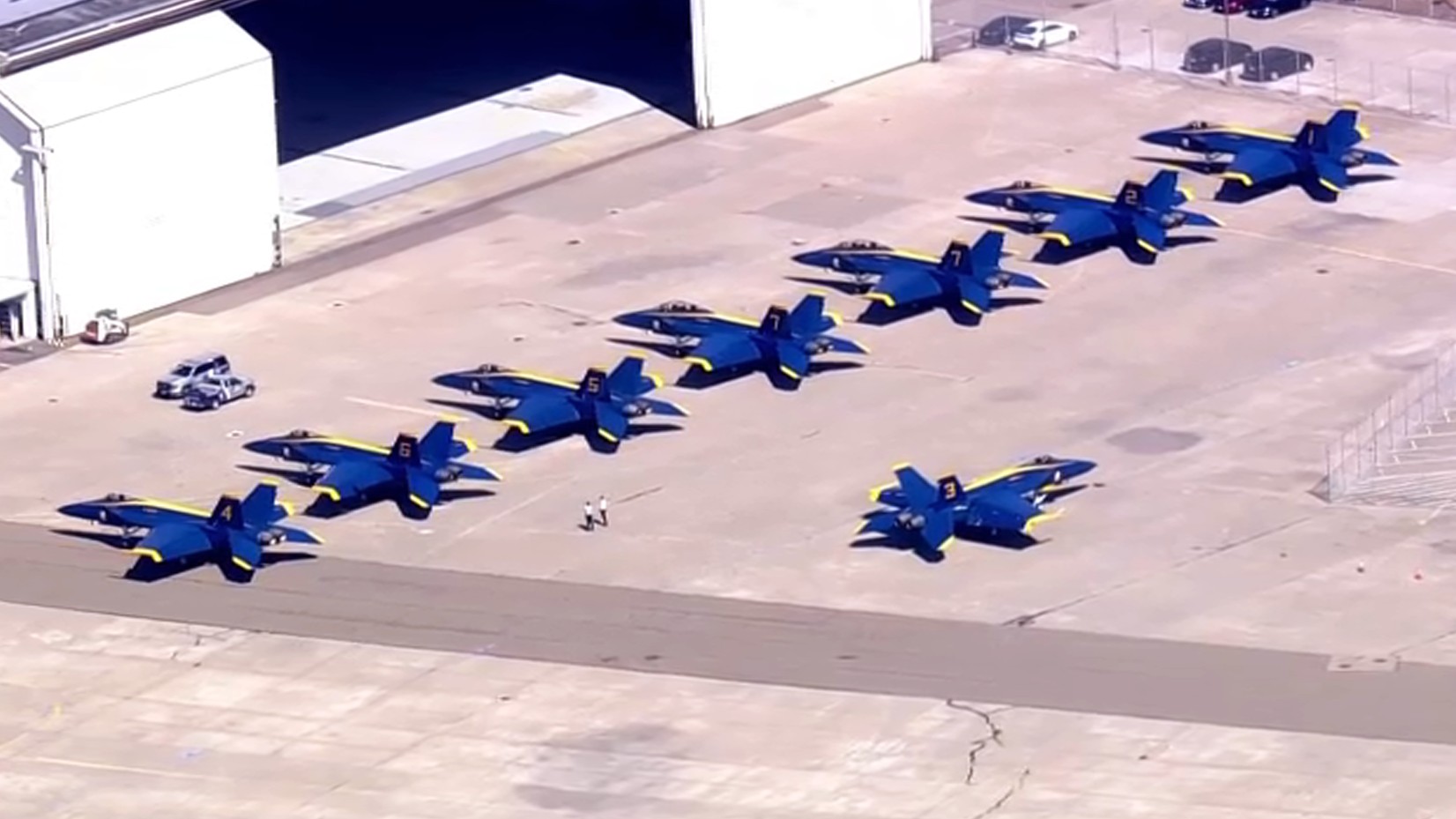
Blue Angels Buzzing the Bay This Weekend for San Francisco Fleet Week
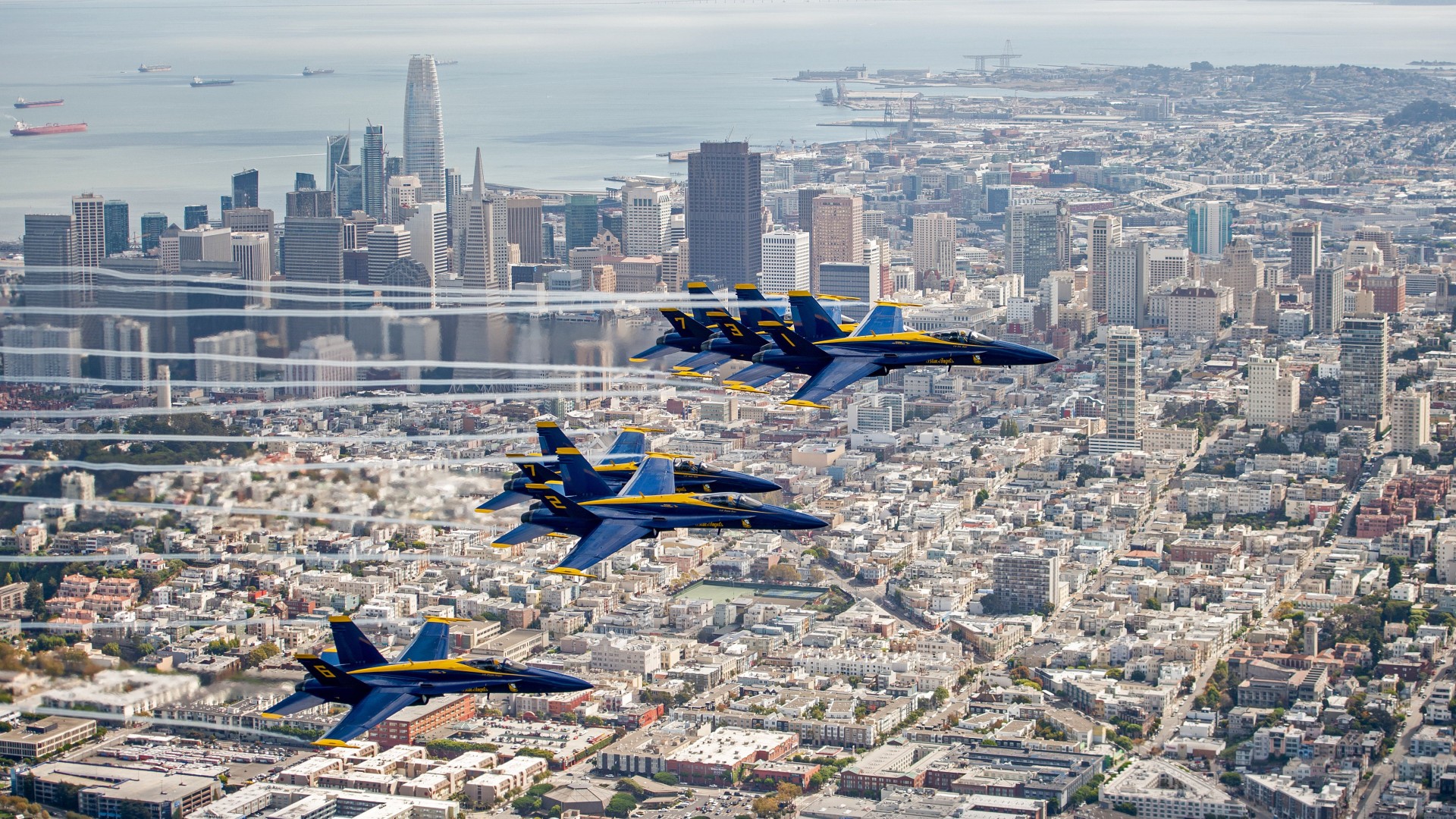
Planning a Rooftop Blue Angels Watch Party in San Francisco? Here's Safety Tips From Firefighters
San francisco fleet week neighborhood concert series.
Enjoy Navy and Marine Corps bands perform during free concerts in neighborhoods across San Francisco. Check out the concert series schedule below.
Monday, Oct. 3
Who: Navy Band Southwest Brass Band When: 5 p.m. Where: Ghirardelli Square (900 North Point St.)
Who: 1st Marine Division Band Old George Popular Music Group When: 7 p.m. Where: The Crossing (200 Folsom St.)
Tuesday, Oct. 4
Who: Navy Band Southwest Brass Band When: Noon Where: Yerba Buena Gardens (760 Howard St.)
Who: Navy Band Southwest Woodwind Quintet When : Noon Where: San Francisco Zoo (Sloat Boulevard and Upper Great Highway)
Who: 1st Marine Division Band Brass Band When: 6 p.m. Where: Noe Valley Town Square (3861 24th St.)
Wednesday, Oct. 5
Who: 1st Marine Division Band Ceremonial Band When: Noon Where: Hayes Valley - Patricia's Green (50 Oak St.)
Who: Navy Band Southwest Destroyers When : Noon Where: 555 California St.
Who: Navy Band Southwest Woodwind Quintet When : Noon Where: Sunset Branch Library on Irving Street (1305 18th Ave.)
Who: Navy Band Southwest Woodwind Quintet When : 3 p.m. Where: Boys and Girls Club of San Francisco - Excelsior Clubhouse (163 London St.)
Who: Navy Band Southwest Brass Band When : 6 p.m. Where: Japan Town Peace Plaza (22 Peace Plaza)
Thursday, Oct. 6
Who: Navy Band Southwest Woodwind Quintet When: Noon Where: Ferry Building Marketplace (1 Ferry Building)
Who: Navy Band Southwest Destroyers When: 5 p.m. Where: Pier 39
Who: Navy Band Southwest Brass Band When: 5:30 p.m. Where: Castro (Jane Warner Plaza)
Who: 1st Marine Division Band Ceremonial Band When: 6 p.m. Where: Herbst Theatre at San Francisco War Memorial & Performing Arts Center (401 Van Ness Ave.)
Friday, Oct. 7
Who: Navy Band Southwest and 1st Marine Division Band When: 10 a.m. Where: ASN Broadcast Site Aquatic Park (700-898 Beach St.)
Who: 1st Marine Division Band Brass Band When: Noon Where: Cable Car Turnaround to Union Square (333 Post St.)
Who: Navy Band Southwest Brass Band When: Noon Where: Golden Gate Park Band Shell (75 Hagiwara Tea Garden Dr.)
Who: 1st Marine Division Band Old George Popular Music Group When: 1 p.m. Where: Union Square Plaza (333 Post St.)
Who: Navy Band Southwest When: 5 p.m. Where: Pier 39
Who: 1st Marine Division Band Ceremonial Band When: 6 p.m. Where: 557 Valencia St.
Saturday, Oct. 8
Who: 1st Marine Division Band Ceremonial Band When: 10 a.m. Where: Duboce Park (Duboce and Scott streets)
Who: Navy Band Southwest Brass Band When: Noon Where: Fisherman's Wharf Crab Wheel Plaza (2820 Taylor St.)
Who: 1st Marine Division Band Brass Band When: 1 p.m. Where: Polk and Jackson streets
Who: Navy Band Southwest Woodwind Quintet When: 1 p.m. Where: Chinatown (Grant Avenue and Commercial Street)
Who: 1st Marine Division Band Brass Band When: 4 p.m. Where: West Portal Courtyard (82 West Portal Ave.)
Who: 1st Marine Division Band Old George Popular Music Group When: 7 - 10 p.m. Where: Westwood (2036 Lombard St.)
Sunday, Oct. 9
Who: 1st Marine Division Band and Navy Band Southwest When: 9 a.m. Where: Presidio Chapel (130 Fisher Loop)
Who: 1st Marine Division Band Ceremonial Band When: 11:30 a.m. Where: Jefferson and Powell streets to Washington Park
Who: Navy Band Southwest Ceremonial Band When: 11:30 a.m. Where: Jefferson and Powell streets to Washington Park
Who: 1st Marine Division Band Ceremonial Band When: 5 p.m. Where: Chase Center (1 Warriors Way)
Monday, Oct. 10
Who: 1st Marine Division Band Brass Band When: 7 p.m. Where: Bayview Dr. George W. Davis Senior Center (1751 Carroll Ave.)
For information about other Fleet Week events, visit the San Francisco Fleet Week website .
Get updates on what's happening in the Bay Area to your inbox. Sign up for our News Headlines newsletter.
This article tagged under:

Fleet Week Air Show Cruise
The ultimate san francisco fleet week experience.
Get ready for heart-pumping excitement as you watch the incredible San Francisco Fleet Week air show headlined by the Blue Angels from the best seats in the house. With our afternoon departures on Friday, Oct. 11, Saturday, Oct. 12, and Sunday, Oct. 13, you'll have a front row seat for all the thrilling aerobatics
We've got you covered with two drink tickets and a full cash bar with additional drinks available for purchase.
Bring some cash to keep things moving and avoid any delays caused by often spotty WiFi on the Bay during the air show.
Experience Fleet Week like never before with Red and White Fleet!
Departure Time: 1:45pm Pricing: $105 adults (ages 21+) $65 youth (5-20) 4 and Under Free
Cruise is approximately 2 hours and will return following the air show.
Psst! Here's a pro tip - don't wait to book your tickets for our airshow cruises. The y sell out fast!
Sorry, Red and White does not offer refunds. All sales are final.
- Top SF Attractions
- Fisherman's Wharf
- Golden Gate Bridge
- Lombard Street
- Ghirardelli Square
- Golden Gate Park
- Japanese Tea Garden
- Haight Ashbury
- San Francisco Beaches
- Conservatory of Flowers
- Botanical Garden
- The Embarcadero
- California Academy of Sciences
- The Exploratorium
- de Young Art Museum
- Legion of Honor Art Museum
- Musée Mécanique
- 65 Things to Do in San Francisco
- Ride the Cable Cars
- SF Bay Cruises
- Bike the Bridge
- Go Car Tours
- Best Places to Stay in SF
- Chinese New Year
- Cherry Blossom Festival
- Christmas in SF
- Napa Wineries
- Angel Island
- Santa Cruz Boardwalk
- Whitewater Rafting
- Vintage Plane Rides
- Getting Around SF
- When to Visit SF
- Parking Tips for SF
- SF Homelessness
- Bad SF Travel Advice

By Karen
Updated July 20, 2024.
Parade of Ships and Ship Tours 2024
SF Fleet Week - Oct 7-14, 2024
Parade of Ships
Ship Tours
Map of Ship Tours
Parade of Ships 2024: Friday of Fleet Week, October 11 , 2024, at 11:00 am.
Ship Tours Schedule for 2024 - TBA
Here is last year's schedule:
Wednesday, Oct. 4: 10-2, Pier 30/32. Thursday, Oct. 5: 10-4, Pier 30/32. Friday, Oct. 6: No ship tours. Saturday, Oct. 7: 10-4, Piers 30/32 & 35. Sunday, Oct. 8: 10-4, Piers 30/32 & 35. Monday, Oct. 9: 9-12, Piers 30/32 & 35.
See below for ship schedules and locations.
Note: locations of specific ships aren't announced now until the ships are at the docks.
To kick off Fleet Week in San Francisco, the Navy sends a line of ships sailing under the Golden Gate Bridge and past the waterfront area.
Some of these ships are available to explore during the ship tours.
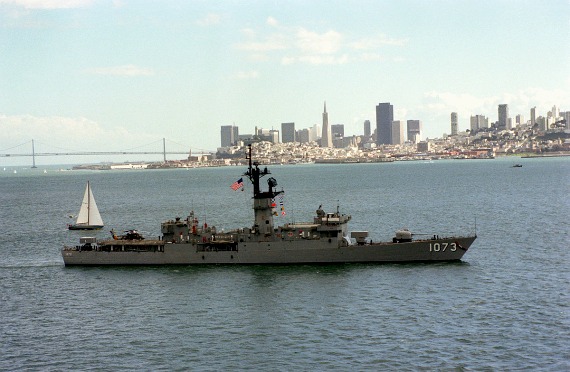
The parade begins at 11:00 a.m . on Friday of Fleet Week , October 11, 2024 , with the first ship passing under the bridge, followed by the remaining ships.
The procession usually continues for an hour or two.
Best Places to Watch
There is a good view of the ships anywhere along the waterfront from the bridge itself to the Ferry Building at the end of Market Street.
Fleet Week Ship Tours
The locations of the specific U.S Navy ships aren't announced until the ships are in place at the docks (for security reasons).
The US Coast Guard ship will be at Pier 19 (possibly) .
The US Navy ships will probably be at Piers 35 and 30/32 .
Go onboard the ships...
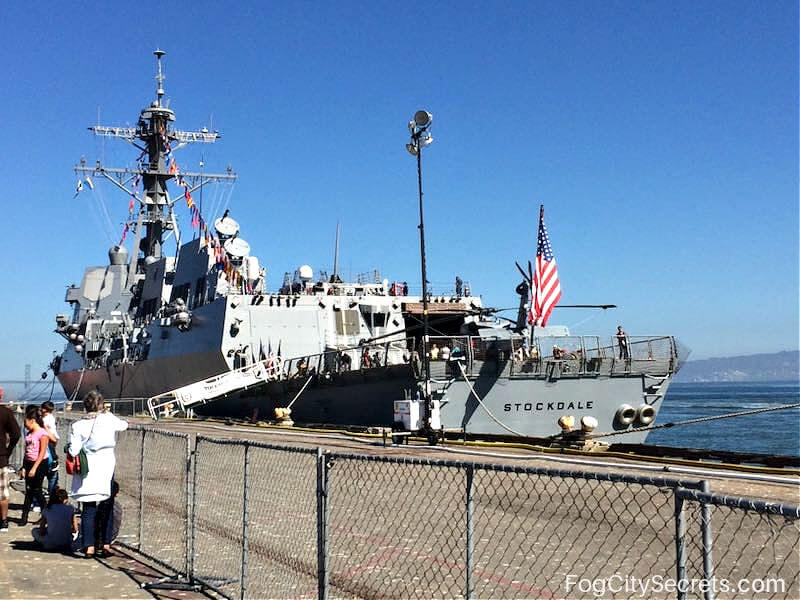
Each year, typically five of the Navy and Coast Guard ships have open houses.
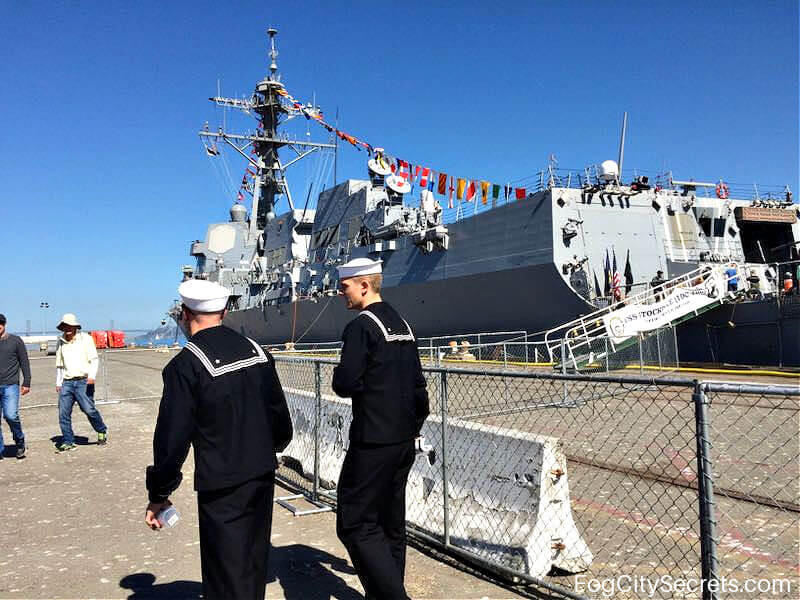
The public is invited to go aboard, meet the sailors and explore the war ships: pretty cool.
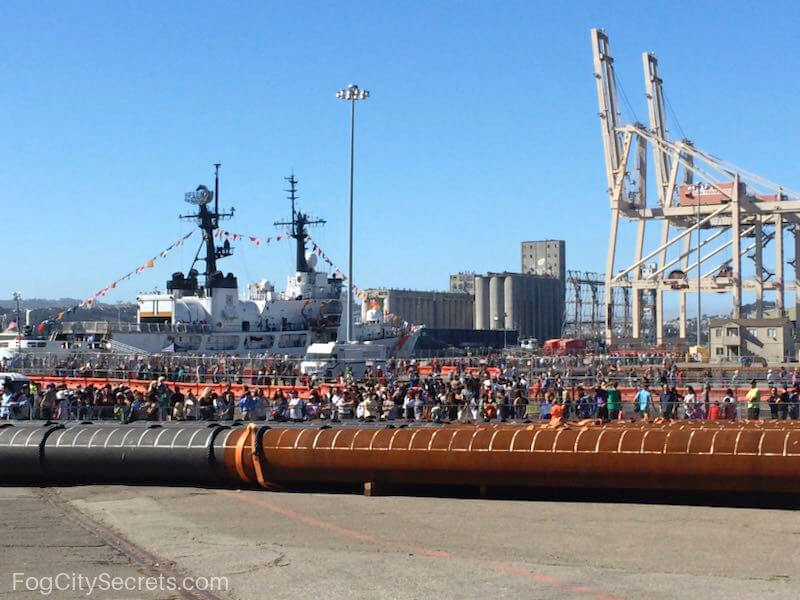
Advice for every year: this is very popular, so go early if you can. Expect some serious lines.
Ship tours are free .
Important: be sure to check out the Navy's requirements for visiting the ships, e.g. no children under 7, government-issued, photo ID's required for all 18 and over, no high heels, no large backpacks or large purses (what = "large"?), no glass containers, no pets including service animals, etc.
Plus, there is no storage area for bicycles, skateboards, or strollers, and they can't be left on the pier near the ships.
See current status on the official Fleet Week site for more info.
In 2024, masks are not required to board the ships.
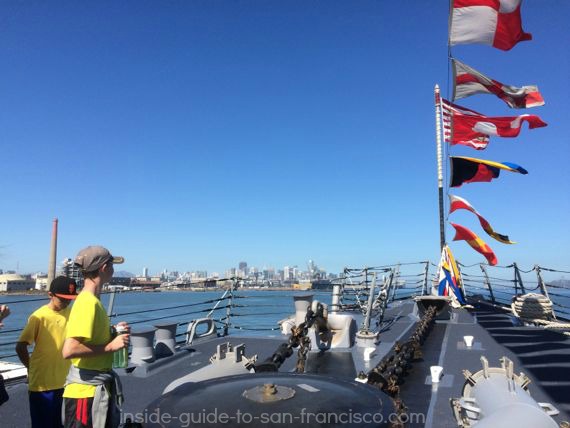
Some ships from previous years
They usually have the same types of ships each year, though the individual ships vary.
This gives you an idea of what will be available for tours.
Ships from 2023...
Uss john p murtha (lpd-26).
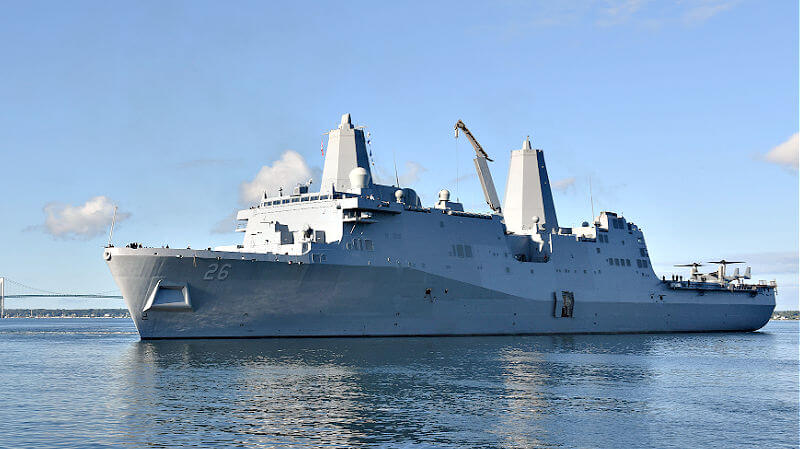
USS Paul Hamilton (DDG-60)
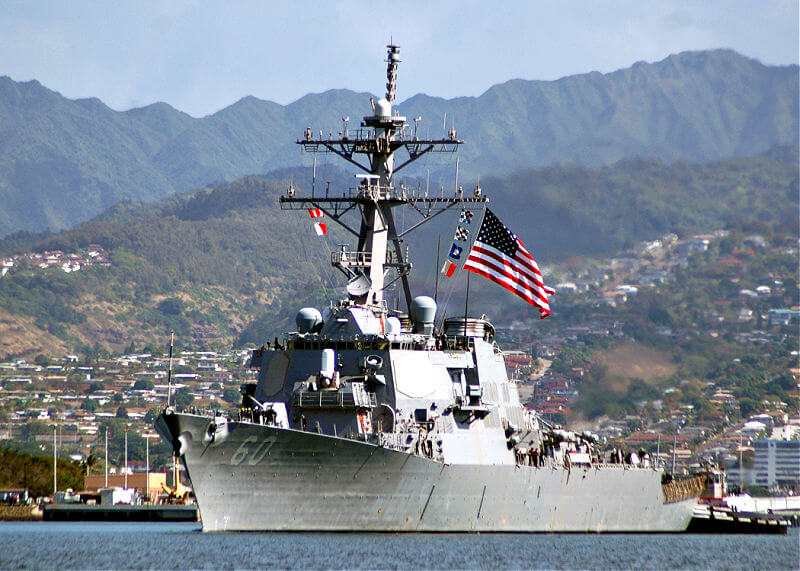
Ships from 2022...
Here are some of the ships from 2022. They usually have the same types of ships each year, though the individual ships vary.
USS Fitzgerald (DDG 62)
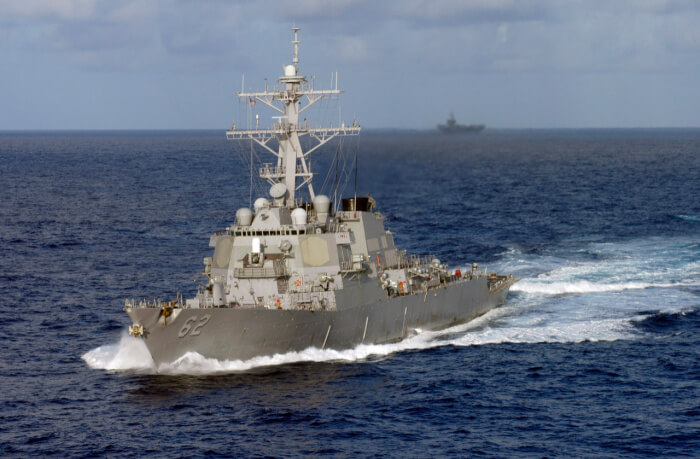
The USS Fitzgerald is a guided missile destroyer , commissioned in 1995 and based in San Diego.
The ship was named after Lieutenant William C. Fitzgerald who was killed in combat in Vietnam in 1967. He received the Navy Cross for heroism in sacrificing himself to save his men.
The Fitzgerald was involved in a serious accident in 2017 when it collided with a Philippine container ship near Japan. Seven crewmen were killed, including the ship's commanding officer. The investigation concluded it was caused at least in part by crew failures, and the damage repairs took two years. See article on the investigation for details.
USS Princeton (CG 59)

The USS Princeton is a Ticonderoga-class, guided-missile cruiser . The ship can launch short and long range missiles, and carries anti-submarine helicopters.
The Princeton hit a mine during Operation Desert Storm in 1991 and was severely damaged, and three crew members were injured.
She was commissioned in 1989 and is based in Long Beach.
USS Harpers Ferry (LSD 49)

The USS Harpers Ferry is an amphibious assault ship that transports troops, equipment, vehicles, and helicopters for beach landings.
She has been involved in a number of humanitarian missions over the years, performing rescues due to cyclones, typhoons, earthquakes and a ship sinking.
The Harpers Ferry was commissioned in 1995 and is due to be retired in 2024.

USS Kansas City (LCS 22)
The USS Kansas City is a littoral combat ship designed for quick maneuvering close to shore. It can land troops, clear mines, and protect larger ships. The ship also carries missile launchers and helicopters that take off from its deck.
The USS Kansas City is a relatively new addition to the US Navy, built in 2018 and commissioned in 2021. The home port is San Diego.
USCGC Terrell Horne (WPC 1131)
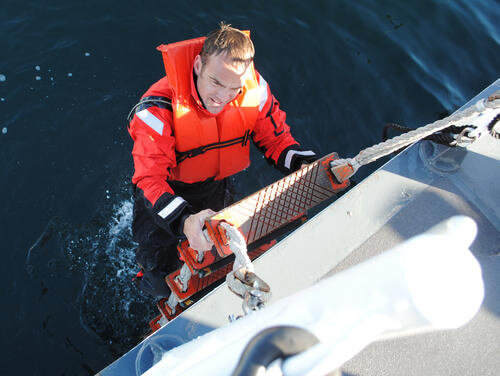
The U.S. Coast Guard Cutter Terrell Horne was commissioned in 2019 and is based in San Pedro, near Los Angeles.
She was named after Senior Chief Petty Officer Terrell Horne III, who died in 2012 protecting his fellow sailors when their boat was rammed by drug smugglers.
Her missions include sea rescues, smuggling enforcement, and patrolling port areas.
Piers with Ship Open Houses in 2023: 19, 30/32 and 35
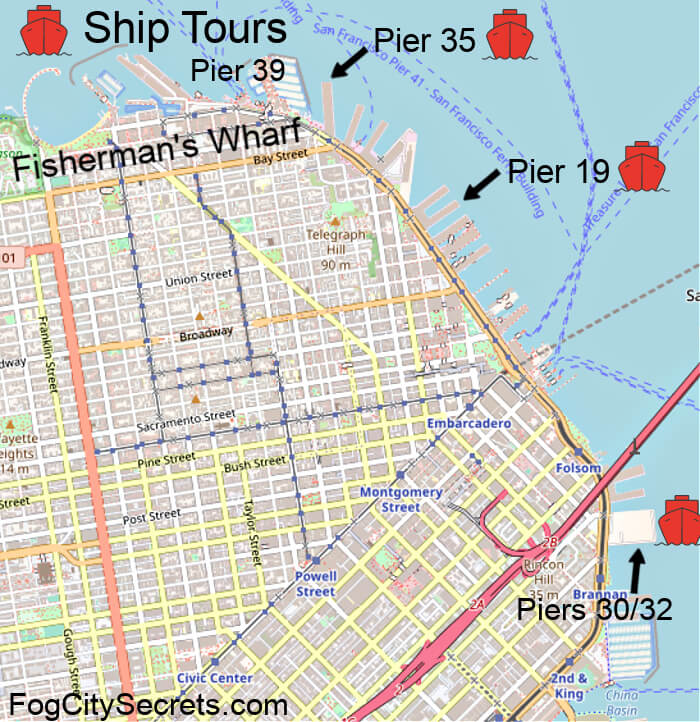
The Coast Guard ship will probably be at Pier 19 , and the other ships will be at the other piers, two ships to a pier.
Pier 35 is near Fisherman's Wharf, and Pier 19 is further down the waterfront towards the Ferry Building.
Piers 30/32 are in the industrial area past the Ferry Building, just on the other side of the Bay Bridge.
Various piers along the San Francisco waterfront are used for the ship tours.
Piers 15/17, 19, 30/32, 35, and 50 have been used for the tours in the past.
Piers 30 and 32 are at the end of Bryant Street, on the Embarcadero. There is a grand plan to develop this pier into offices and retail spaces, but it hasn't begun yet.
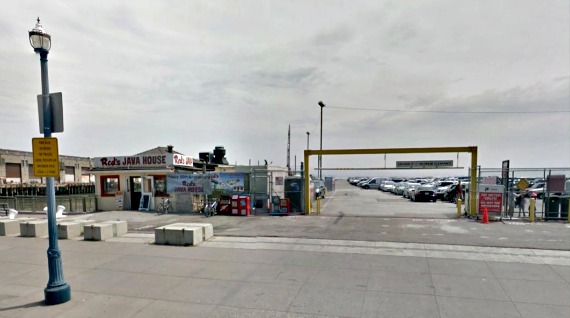
Pier 35 is used to handle the overflow cruise ships when the Cruise Ship Terminal at Pier 27 is in use. The SS Jeremiah O'Brien liberty ship is berthed here now.
It's not far from Pier 39 and Pier 33 (Alcatraz Landing) so parking is challenging.
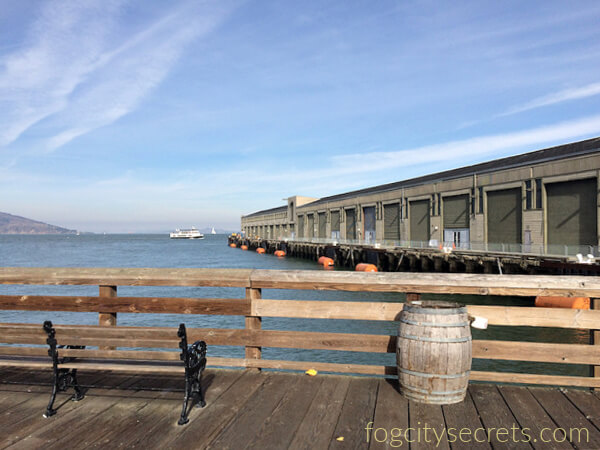
Pier 19 is about halfway between Fisherman's Wharf and the Ferry Building.
Piers 15/17 house the Exploratorium. There's an expensive parking lot across the street (lots of break-ins - beware!).
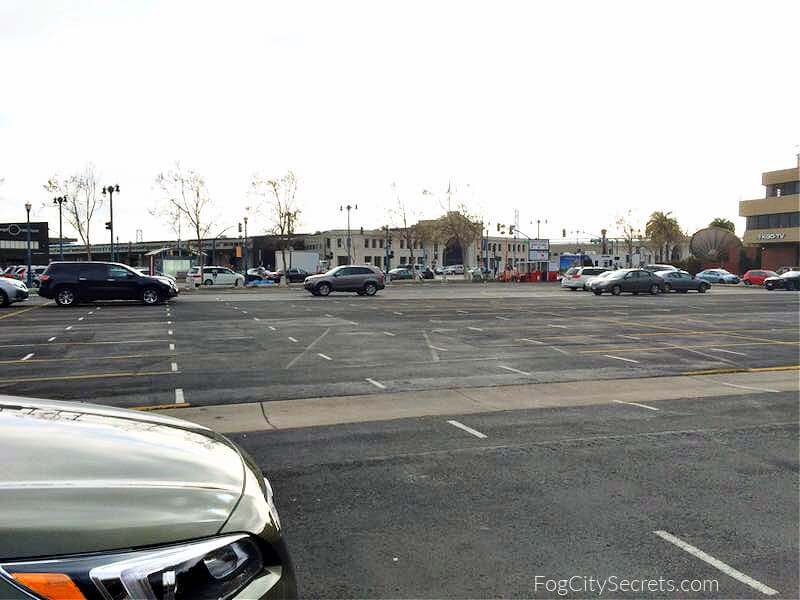
Pier 50 is one of the "industrial" piers south of the Bay Bridge. It's next door to Pier 48, and there's a huge parking lot in front of both of them that's used for baseball game parking at AT&T Park nearby.
See my page on San Francisco piers for maps of all the piers and what's located at each one.
Parking ideas...
For information on parking in the area, see my tips on Embarcadero parking .
Note: I may earn a small commission if you make a purchase through some of the links on this page, at no extra cost to you. This helps me provide all the free information I post on this website.
Another parking option is to book a parking spot in advance through one of the parking apps. I've been using them more and more; you can try Spot Hero for the best possibilities.
Pier 35 usually hosts one of the ships and is right in the heart of things, near Pier 39 and Alcatraz Landing (Pier 33). This area will probably book up the fastest.
Find more information on:
- Fleet Week activities
- The Blue Angels air show in SF
More to explore...
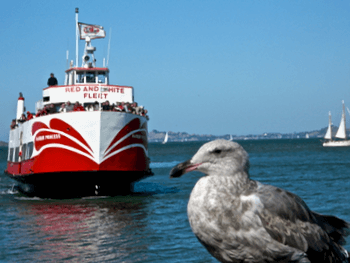
Share this page:
Best things to do in San Francisco
Top San Francisco Attractions

Get the latest tips on visiting San Francisco.
SF Bus, BART & Cable Car Routes
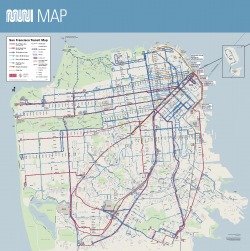
Get Alcatraz tickets...
Home | Sitemap | Contact Me | About Me
Privacy Policy | Use Policy | Affiliate Disclosure
As an Amazon Associate I earn from qualifying purchases.
FogCitySecrets.com Inside-Guide-to-San-Francisco-Tourism.com
Copyright© 2009- . All rights reserved.
SF Fleet Week: 2024 In-Depth Guide

Every year, the city of San Francisco comes alive with the spectacular sights and sounds of SF Fleet Week. Whether you’re a local or a visitor, Fleet Week SF offers a unique opportunity to appreciate maritime traditions, celebrate our armed forces, and marvel at breathtaking air shows featuring the renowned Blue Angels.
With so much packed into a few thrilling days, this guide will ensure you make the most of Fleet Week San Francisco 2024.
What's in this article?
Fleet Week SF Schedule
So, when is Fleet Week SF this year? Join the week-long celebration from October 7 to 14, 2024. Read on for the detailed SF Fleet Week schedule for each event.
SF Fleet Week 2024 Location
The events are centered around the San Francisco waterfront, with the main attractions taking place on the bay and at various locations around the city. Read on for updated locations of each activity.
Admission is free, but note that some events during the week may require separate tickets. Keep reading for more details.
Where to Stay
For the best Fleet Week SF 2024 experience, snag a room in the Marina District or Fisherman’s Wharf . These vibrant neighborhoods put you right in the heart of the action, with stunning views of the Bay, easy access to the air show viewing areas, and plenty of restaurants and shops to explore.
Ready to book your stay for the Fleet Week SF dates? Discover more hotels and find great deals at Tripster.
What to Expect at SF Fleet Week 2024
What is Fleet Week SF? San Francisco Fleet Week is a vibrant and exciting annual event that celebrates the U.S. Navy, Marine Corps, and Coast Guard. It’s a week-long affair filled with patriotic displays, community events, and thrilling air shows that captivate both locals and visitors alike.
Here are some key things you need to know about San Francisco Fleet Week:
Air Show: Dates: October 11-13, 2024
Each year, the breathtaking SF Fleet Week Air Show, presented by United, captivates audiences near the Golden Gate Bridge and Alcatraz. This iconic waterfront event features the exhilarating performances of the U.S. Navy Blue Angels and stands out as the only air show in the country where a commercial airliner, the United 777, delivers a fully choreographed routine.
Don’t miss out on the action! Tickets start at $140. Purchase here .
Parade of Ships: San Francisco Fleet Week boasts the grandest Parade of Ships along the West Coast. Witness the impressive fleet of 2024 sail under the iconic Golden Gate Bridge and discover the diverse array of vessels participating.
Related Post: Bay Cruise San Francisco Guide
From the Golden Gate Bridge to the Bay Bridge, the procession offers fantastic viewing opportunities. The reviewing stand is located at Marina Green. Kicking off the parade, the San Francisco Fire Department’s fire boat will dazzle onlookers with jets of water celebrating the fleet’s grand arrival.
Ship Tours: Step aboard the impressive amphibious carriers, cutters, destroyers, and cruisers anchored at the Embarcadero. Here, you can get an up-close look at the daily lives of the dedicated sailors serving in the U.S. Navy and the U.S. Coast Guard.
Honor Our Fallen Concert: Venue: The Herbst Theatre, located at 401 Van Ness Ave
Come experience a heartfelt tribute by the United States Marine Corps 1st Marine Division Band. This special performance honors the brave service members who volunteered to defend their country, paying the ultimate sacrifice during the Iraq and Afghanistan conflicts.
Related Post: San Francisco Indoor Activities
Neighborhood Concert Series: This is a fantastic opportunity for San Franciscans to engage with the incredible servicemen and servicewomen through exciting performances happening all around the city.
Stay tuned for the 2024 concert schedule to find out who’s performing in your neighborhood!
K9 Heroes: Saturday, October 12, 2024, 10:00 am – 2:00 pm at Duboce Park
Right in the heart of San Francisco at Duboce Park, regional and national K9 services showcase their talented stars, performing tasks like search and rescue, therapy, drug and food detection, law enforcement, and bomb detection.
This event draws dog lovers and features vendor booths from pet service providers and various agencies, celebrating our heroic canine friends. Bring your family and furry friends to witness how these four-legged heroes make a difference in so many lives.
Nearby Attractions and Experiences
Make the most of your SF Fleet Week experience by exploring San Francisco’s renowned nearby attractions .
Whether you’re interested in iconic landmarks, family-friendly activities , or culinary delights , booking discount tickets through Tripster offers the perfect way to blend adventure with savings.
Dive into the full spectrum of the city’s charm and make unforgettable memories during your Fleet Week visit!
Tips and Parking
Where to watch Fleet Week SF : Wondering where is the best place to watch Fleet Week SF? To fully experience the awe-inspiring air show, these prime spots offer the best views of the aerial acrobatics:
- Crissy Field: Witness the Fleet Week SF Blue Angels fly directly overhead against the backdrop of the Golden Gate Bridge. Get there early to snag a spot on the vast lawn.
- Marina Green: This expansive park offers unobstructed views of the air show and Golden Gate Bridge, plus ample space to spread out and enjoy the spectacle.
- Aquatic Park: Catch the action from a unique perspective at this historic waterfront park, with views of the bay, Alcatraz, and the aerobatic displays.
Related Post: San Francisco Christmas Ultimate Guide
- Pier 39: Enjoy the air show with the lively atmosphere of Pier 39. Grab a bite to eat and soak in the stunning views of the bay and the aerial performance.
- Bay Cruise: For an unparalleled experience, consider a boat tour during the air show. Watch the Blue Angels soar above the water, creating an unforgettable memory.
What to Bring : For an enjoyable experience at SF Fleet Week 2024, consider bringing essentials such as sunscreen , a hat, comfortable seating, snacks, and binoculars for a closer view of the exciting air show performances. A small cooler can help keep your beverages cool and your spirits high all day long!
Parking : It’s a good idea to reserve convenient and budget-friendly parking ahead of time using SpotHero, the top parking reservations app in the country.
Plan Your Visit to San Francisco Fleet Week
With its rich blend of military tradition, thrilling air shows, and spectacular performances, San Francisco Fleet Week promises an unforgettable experience for everyone. Whether you’re a first-time visitor or a dedicated fan, planning ahead will ensure you don’t miss a moment of excitement.
Mark your calendar, gather your friends and family, and get ready to witness the exhilarating displays by the Blue Angels at one of San Francisco’s most celebrated events. Enjoy the sights, sounds, and spirit of Fleet Week SF, and create memories that will last a lifetime. See you at Fleet Week SF 2024!
PS: These are affiliate products, so if you choose to buy, Tripster might earn a commission.
Start Date:
October 7, 2024
October 14, 2024
Categories:
Events in San Francisco
San Francisco , CA United States

Written by Anne Joyce Raymundo
Anne is a Filipino writer who formerly managed and created marketing strategies and materials for numerous websites and eCommerce platforms. Now, her voice...
Have something to add? Post it here: Cancel reply
Your email address will not be published. Required fields are marked *
Save my name, email, and website in this browser for the next time I comment.
Related Events
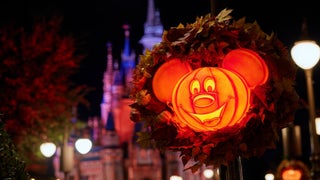
Aug 9, 2024 - Oct 31, 2024

Aug 23, 2024 - Nov 2, 2024
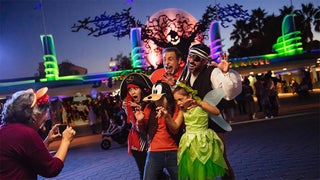
Aug 25, 2024 - Oct 31, 2024
Are you a Tripster?
Create an account to get access to exclusive pricing and rewards.
Book Your Trip
Read more about.

- Search Experiences
- Manage Booking
- Phone # SMS #
- My Offers 5
Sail into San Francisco Fleet Week 2024
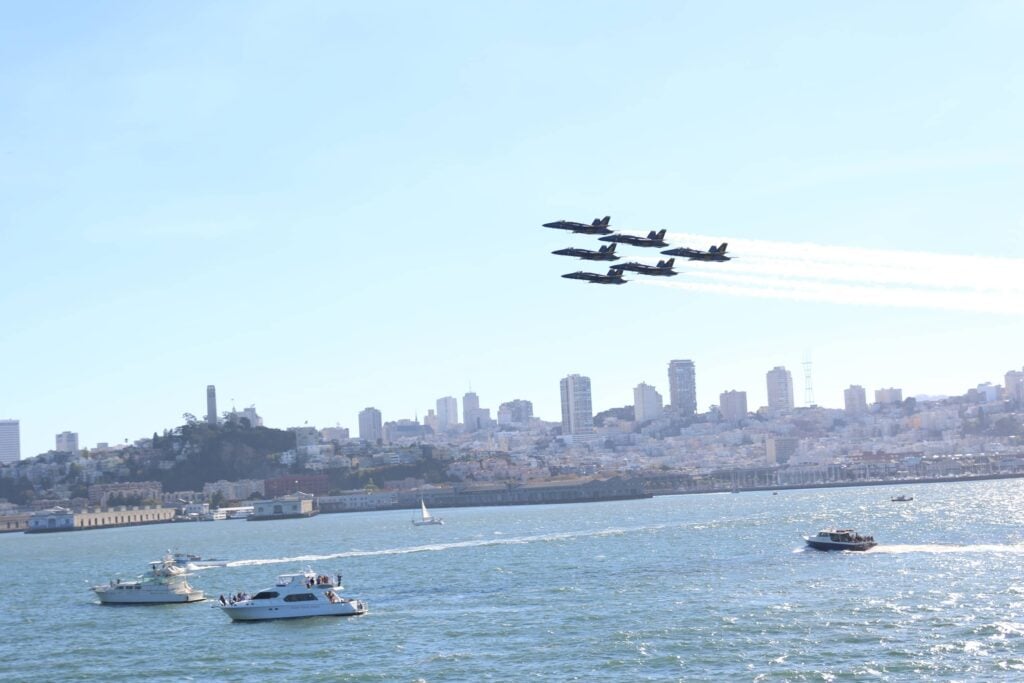
Featured in this post
Keep exploring.
San Francisco, California
Essential San Francisco
Explore More
San Francisco Fleet Week (October 7-14, 2024) is one of the most highly anticipated events of the season. Drawing in more than a million people every year, it’s the top ticket for those looking to experience the heart-pumping Air Show and ship tours that can be seen and heard all around you. It’s also an important event as it celebrates our naval forces.
The San Francisco Fleet Week Air Show 2024’s lineup features the United States Blue Angels , soaring above the crowds from October 11-13 th , with a fully choreographed act featuring a commercial airliner, the United 777. The San Francisco Fleet Week Air Show is the only event in the United States to do so. “Fat Albert”, a Lockheed Martin C-130J Hercules carrying the maintenance equipment for the Blue Angels, is also returning as well as a demo from a Marine F-35B fighter jet that will dip and delight in unison and is sure to impress the masses. You can also enjoy the Parade of Ships on Friday from the best seat in the house, aboard a City Cruises yacht! See the famous Blue Angels from the water with their jaw-dropping maneuvers and the jets humming engines above you!
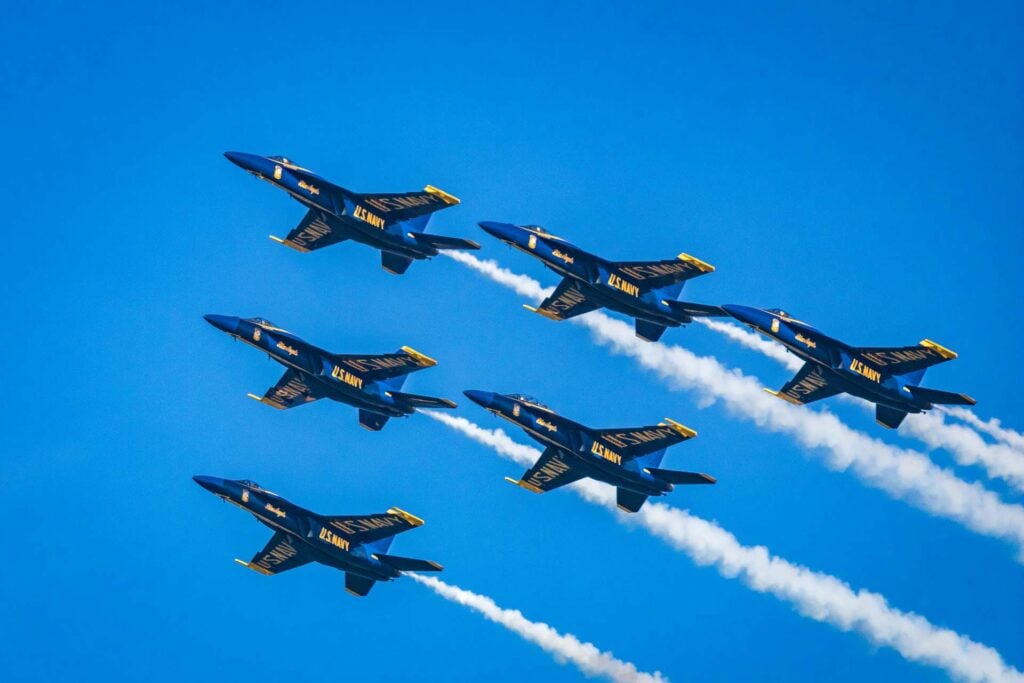
History of San Francisco’s Fleet Week
Fleet week in San Francisco dates back to 1981, when then Mayor, Dianne Feinstein, rolled out the red carpet for Sailors, “Coasties”, Marines, and their families in celebration of naval services with a spectacular (and sometimes frightening) airshow. There would also be a parade of ships and neighborhood festivities in honor of the brave men and women who have served our country. Since then, Fleet Week in San Francisco has taken place on the Marina Green, with many community events and live music. This is the largest and most significant event of its kind in the nation. It also features a unique training and education program that brings together civilians and the military to develop and share best practices in humanitarian assistance and emergency disaster response. This incredible event serves as the model for fleet weeks across the country, and brings in an estimated $10 million in revenue to the city annually.
Kickoff Event for Fleet Week 2024
This year the United States Marine Corps Band , the very best of Marine Corps music and the “pride of the division”, kick off the event with a performance of patriotic songs and musical celebration. The music continues as select Bay Area high school bands take the stage, competing for prize money to support their local music programs.
The Best Seat in the House – on San Francisco Bay!
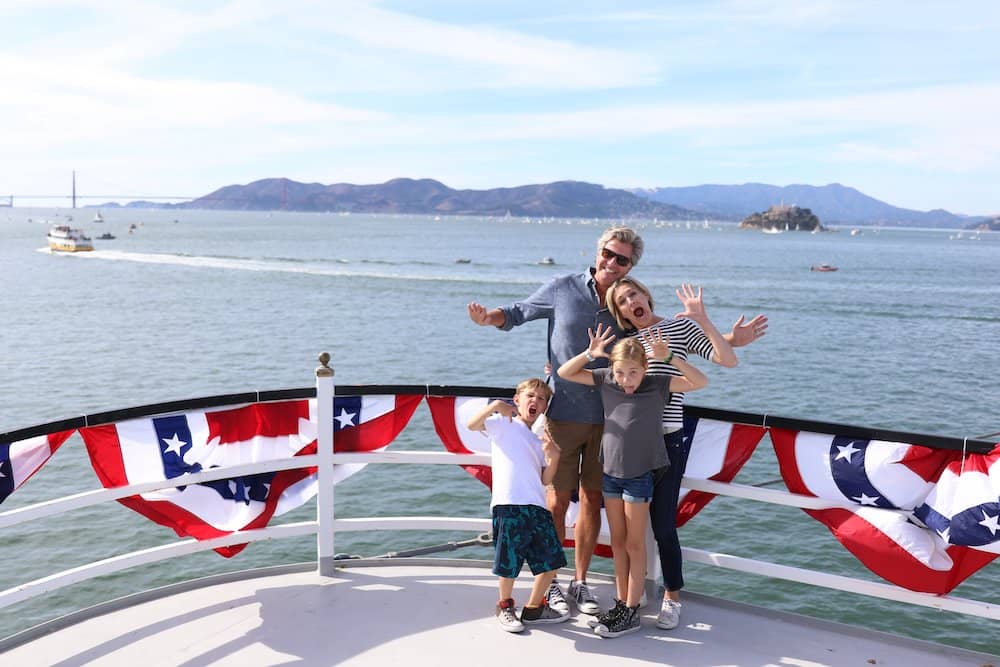
San Francisco’s Fleet Week Highlights

San Francisco Fleet Week Soaring into 2024
This year’s San Francisco Fleet Week is expecting hundreds of thousands of people to gather on the city’s waterfront and Embarcadero for a parade of warships and the main event, the airshow by the U.S. Blue Angels. All ages come together to honor fellow service members in uniform. Spectators can be seen ogling at zooming jets above and boarding ships to get a peek at missile launchers. San Francisco’s Fleet Week has become a model for similar celebrations around the country and is a must-see in the Bay Area. With free concerts, parades, K9 heroes, an amazing lunch cruise , and great events surrounding you. Experience an exhilarating celebration of our nation’s naval heritage, breathtaking air shows, and the unique opportunity to interact with service members, all set against the stunning backdrop of the iconic San Francisco Bay. Get ready to be dazzled!
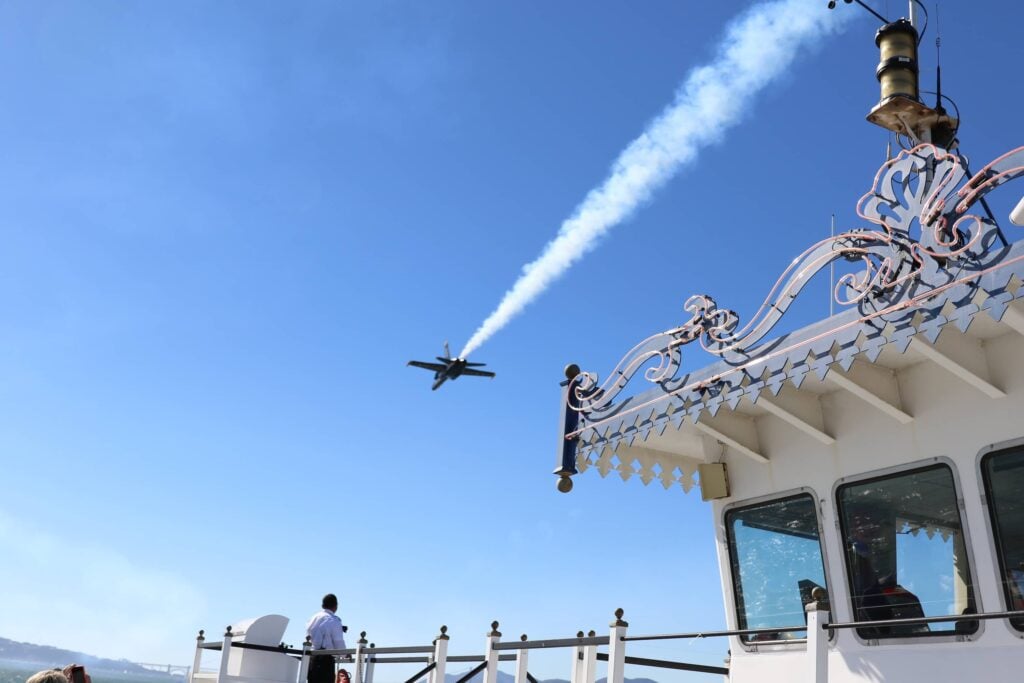
FAQs – San Francisco Fleet Week 2024
What are the main events during san francisco fleet week.
Key events include the Air Show featuring the Blue Angels, the Parade of Ships, ship tours, and various community events like the Humanitarian Assistance Village, STEM Center, and Concert Series. The official website will give you insight into all the activities listed here .
What is special about the Fleet Week cruises?
These cruises offer spectacular views of the Blue Angels and other air show performances. They often include amenities like beverages, light snacks, or even full meals, and provide a comfortable and unique perspective on the festivities.
Are there any specific recommendations for watching the Air Show?
Popular viewing spots include Pier 39, Aquatic Park, Crissy Field, and Marina Green. Each location offers a different experience, with some being more crowded than others.
How can I experience Fleet Week with City Cruises in San Francisco?
City Cruises offers special cruises during Fleet Week, providing a unique perspective to view the Air Show and Parade of Ships from the water.
What are the benefits of watching the Fleet Week Air Show with City Cruises?
Viewing the Air Show from a City Cruises vessel offers a less crowded, more relaxed environment with stunning views of the Blue Angels and other performers over the bay.
Does City Cruises offer any special amenities during Fleet Week?
City Cruises typically provide amenities like food and beverages, making the experience more enjoyable and comfortable.
What types of ships are involved in Fleet Week’s Parade of Ships?
The Parade of Ships typically features a variety of military vessels, including amphibious transport docks and guided missile destroyers. Each year can have different participating ships.
Are there any educational or community-focused events during Fleet Week?
Yes, Fleet Week includes events like the Humanitarian Assistance Village and STEM Center, which focus on community education and engagement.
How can I participate in ship tours during Fleet Week?
Ship tours are usually free and open to the public on a first-come, first-served basis. Visitors should check specific schedules and requirements, such as showing a valid ID for adults.
What are some tips for attending the Fleet Week events?
It’s recommended to arrive early at events, especially the Air Show, as popular spots can get crowded. Also, consider wearing comfortable shoes and bringing ear protection for loud performances.
Is there any special significance of Fleet Week in San Francisco?
San Francisco Fleet Week celebrates the Bay Area’s naval history and the contributions of the men and women of the United States Armed Forces, fostering a deeper appreciation and understanding among the civilian population.
Original Post Date: September 25, 2023
Be the first to get offers and news
Shopping cart, find your experience.
- Skip to global NPS navigation
- Skip to the main content
- Skip to the footer section

Exiting nps.gov
Liberty ships and victory ships, america's lifeline in war (teaching with historic places).
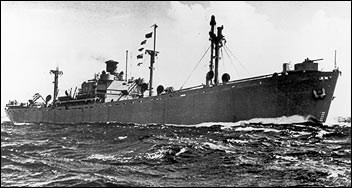
The officers and men of the Merchant Marine, by their devotion to duty in the face of enemy action, as well as natural dangers of the sea, have brought us the tools to finish the job. Their contribution to final victory will be long remembered.
--General Dwight D. Eisenhower on National Maritime Day, 1945¹
In the nearly 20 years following the end of the World War I, America's merchant fleet, including its cargo and passenger ships, was becoming obsolete and declining in numbers. A shipbuilding program began with the passage of the Merchant Marine Act of 1936. However, World War II provided the impetus to intensify those efforts eventually leading to a ship-building program that produced 5,500 vessels. Among them were 2,710 mass-produced ships known as Liberty ships. While reviewing blueprints of the Liberty ships at the White House, President Franklin D. Roosevelt, who loved naval vessels and had an eye for design, mused aloud to Maritime Commission administrator Admiral Emory S. Land, "I think this ship will do us very well. She'll carry a good load. She isn't much to look at, though, is she? A real ugly duckling."² Thus, the Liberty ships received their second nickname, "the ugly ducklings."
When the United States entered World War II at the end of 1941, it had the beginnings of a great merchant fleet. But the lethal U-Boats, submarines of the German Navy, prowled the shipping lanes hunting American merchant ships. The Liberty ships proved to be too slow and too small to carry the tons of supplies the United States and her Allies would need to win the war. In 1943, the United States began a new ship-building program. These new ships would be faster, larger, and able to carry cargo long after the war was finished. These were the Victory ships. The Liberty and Victory ships fulfilled President Roosevelt's prophetic words, serving the nation well in war and peace. Today, of the thousands of Liberty ships and Victory ships built during World War II, only a handful remain. ¹ War Shipping Administration, Press Release 2277(W), Maritime Day 1945--Military Leaders Praise Merchant Marine (18 May 1945). ² John G. Bunker, Liberty Ships: The Ugly Ducklings of World War II (Annapolis, Maryland: Naval Institute Press, 1972) p. 6.
About This Lesson
This lesson is based on the National Register of Historic Places registration files for the SS John W. Brown, the SS Jeremiah O'Brien (with photographs ), the SS American Victory, and the SS Red Oak Victory, the National Historic Landmark nomination file for the SS Lane Victory (with photographs ), and other sources. Jay Michalsky, a historical researcher, wrote this lesson. Jean West, education consultant, and the Teaching with Historic Places staff edited the lesson. This lesson is one in a series that brings important stories of historic places into classrooms across the country.
Where it fits into the curriculum
Topics: This lesson can be used in U.S. history, world history, social studies, and geography courses on World War II. Time period: World War II
United States History Standards for Grades 5-12
Liberty Ships and Victory Ships, America's Lifeline in War relates to the following National Standards for History:
Era 8: The Great Depression and World War II (1929-1945)
Standard 3A- The student understands the international background of World War II.
Standard 3B- The student understands World War II and how the Allies prevailed.
Standard 3C- The student understands the effects of World War II at home.
Curriculum Standards for Social Studies
National Council for the Social Studies
Liberty Ships and Victory Ships, America's Lifeline in War relates to the following Social Studies Standards : Theme II: Time, Continuity and Change
Standard B - The student identifies and uses key concepts such as chronology, causality, change, conflict, and complexity to explain, analyze, and show connections among patterns of historical change and continuity.
Standard C - The student identifies and describes selected historical periods and patterns of change within and across cultures, such as the rise of civilizations, the development of transportation systems, the growth and breakdown of colonial systems, and others.
Theme III: People, Places and Environments
Standard A - The student elaborates mental maps of locales, regions, and the world that demonstrate understanding of relative location, direction, size, and shape.
Theme V: Individuals, Groups, and Institutions
Standard A - The student demonstrates an understanding of concepts such as role, status, and social class in describing the interactions of individuals and social groups.
Standard B - The student analyzes group and institutional influences on people, events, and elements of culture.
Standard G - The student applies knowledge of how groups and institutions work to meet individual needs and promote the common good.
Theme VI: Power, Authority and Governance
Standard C - The student analyzes and explains ideas and governmental mechanisms to meet wants and needs of citizens, regulate territory, manage conflict, and establish order and security.
Standard G - The student describes and analyzes the role of technology in communications, transportation, information-processing, weapons development, and other areas as it contributes to or helps resolves issues.
Theme VII: Production, Distribution and Consumption
Standard A - The student gives and explain examples of ways that economic systems structure choices about how goods and services are to be produced and distributed.
Standard D - The student describes a range of examples of the various institutions that make up economic systems such as households, business firms, banks, government agencies, labor unions, and corporations.
Objectives for students
1) To outline the reasons behind the massive merchant-ship building program the United States undertook in the years before its entry in World War II. 2) To examine how changing technology affected the conduct of warfare. 3) To compare and contrast the Liberty ships and the Victory ships. 4) To conduct oral histories with local people involved in supporting the war effort.
Materials for students
The materials listed below either can be used directly on the computer or can be printed out, photocopied, and distributed to students. The maps and images appear twice: in a smaller, low-resolution version with associated questions and alone in a larger version. 1) two maps showing selected shipyards in the United States and the North Atlantic Ocean; 2) three readings about Liberty ships and Victory ships; 3) four photos of Liberty ships, Victory ships, and convoys; 4) one stamp showing a Liberty ship.
Visiting the site
The Liberty Ship SS Jeremiah O'Brien is located at Pier 45 on Fisherman's Wharf in San Francisco, California. The ship is open to the public and cruises are available. The ship is open daily from 10:00 a.m. to 4:00 p.m., except on New Year's Day, Thanksgiving, and Christmas. There is an admission charge. For more information, contact the National Liberty Ship Memorial, Pier 23, San Francisco, CA 94111, or visit the ship's website . The Liberty Ship SS John W. Brown is located in Baltimore, Maryland. The ship is open to the public and cruises are available. The ship is open Sundays and Wednesdays from 9:00 a.m. to 2:00 p.m., except on Christmas. From I-95 take the Keith Avenue exit. Follow Keith Avenue west to Clinton Street. Turn right on Clinton Street and proceed to 2000 S. Clinton Street, Pier 1. For more information, contact Project Liberty Ship, P.O. Box 25846, Highlandtown Station, Baltimore, MD 21224, or visit the ship's website . The Victory Ship SS American Victory is located near the Florida Aquarium in Tampa, Florida at Berth 271. The ship is open to the public and cruises are available. The ship is open Monday through Saturday 10:00 a.m. to 5:00 p.m. and Sundays 12:00 p.m. to 5:00 p.m. There is an admission charge. From I-275 take the Downtown East exit to Jefferson Street. Continue south on Jefferson Street to Twiggs Street. Turn left on Twiggs Street to Channelside Drive. Turn right on Channelside Drive to York Street. Turn left on York Street to the Florida Aquarium parking lot. For more information, contact American Victory Ship, 705 Channelside Drive, Tampa, FL 33602, or visit the ship's website . The Victory Ship SS Lane Victory is located at the Los Angeles Harbor in San Pedro, California. The ship is open to the public and cruises are available. The ship is open daily from 9:00 a.m. to 4:00 p.m. There is an admission charge. From the Harbor Freeway (I-110) take the Harbor Boulevard exit. Stay to the right and follow the signs to Harbor Boulevard. Once off the freeway, stay in the center lane and go into the Catalina Terminal. Follow the signs to the SS Lane Victory at Berth 94. For more information, contact the United States Merchant Marine Veterans of World War II, P.O. Box 629, San Pedro, CA 90733.
The Victory Ship SS Red Oak Victory is located in Richmond, California and is part of the Rosie the Riveter/WWII Home Front National Historical Park. The ship is administered by the Richmond Museum of History and is open to the public. The ship is open seven days a week from 10:00 a.m. to 4:00 p.m. except when there is severe weather. Donations are requested. From either I-80 or I-580 take the Cutting Boulevard exit. Continue west on Cutting Blvd. to a four-way stop sign. Take a left on Dornan Drive through the Ferry Point tunnel to Terminal One, 1500 Dornan Drive. Please note the ship is scheduled to be relocated in early 2005. For more information, contact the SS Red Oak Victory, Terminal 1, 1500 Dornan Drive, Richmond, CA 94801, or visit the ship's website .
Rosie the Riveter/World War II Home Front National Historical Park, located in Richmond, California, preserves and interprets the history of the men and women who worked in the factories and shipyards in Richmond during World War II. It is a partnership between the National Park Service, the City of Richmond, the Rosie the Riveter Trust, and the Richmond Museum of History, and is made up of noncontiguous units near the Richmond waterfront. Many of the units are owned by the City of Richmond while others are privately owned. The park was created in 2000 and is still in development; therefore, certain sites are not yet open to the public. Several units are open to the public, including the Rosie the Riveter Memorial, which is open from dawn to dusk every day, the John J. Sheridan Observation Point, and the Victory Ship SS Red Oak Victory. For more information about the park, contact the Superintendent, Rosie the Riveter/World War II Home Front National Historical Park, 1401 Marina Way South, Richmond, CA 94804 or visit the park's website or the park's partner, the Rosie the Riveter Trust .
Getting Started
Inquiry question.
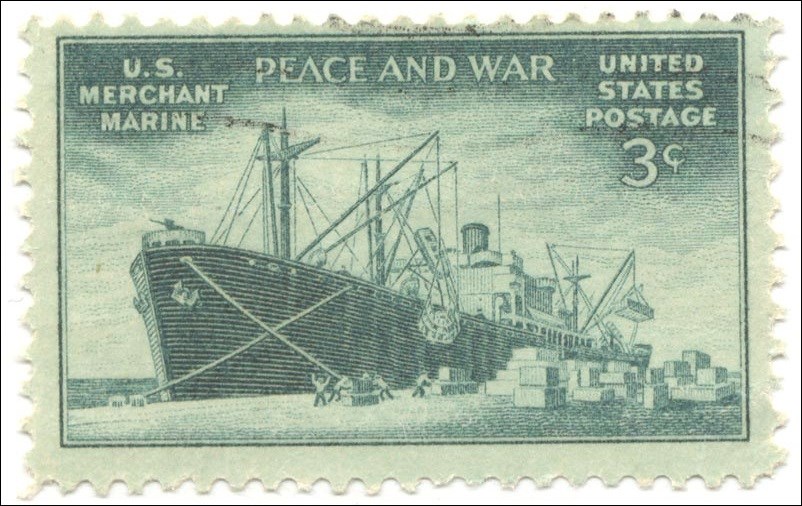
Why do you think the U.S. Post Office issued this stamp?
Setting the Stage
In 1936, Congress passed the Merchant Marine Act, creating the U.S. Maritime Commission to oversee "... that the United States shall have a merchant marine…to provide shipping service essential for maintaining the flow of such domestic and foreign waterborne commerce at all times, capable of serving as a naval and military auxiliary in time of war or national emergency, owned and operated under the United States flag…, composed of the best-equipped, safest, and most suitable types of vessels…, and supplemented by efficient facilities for shipbuilding and ship repair."¹ The fleet of ships responsible for this mission is called the U.S. Merchant Marine. At the time the act was passed, the majority of the ships in the merchant fleet were over 20 years old. The original plan was to build 50 ships per year for 10 years. However, World War II began in 1939, when Hitler's Germany invaded Poland. The United States realized that the existing construction program was not adequate to meet the changing world situation. During World War II the Merchant Marine was nationalized, that is, the U.S. government controlled the cargo and the destinations, contracted with private companies to operate the ships, and put guns and Navy personnel (Armed Guard) on board. The government trained civilian men to operate the ships and assist in manning the guns through the U.S. Maritime Service. With Hitler's attack on Great Britain in 1940, the need for the United States to increase ship production became critical. The British could no longer produce ships in great numbers and also needed food and supplies. The United States knew that if Great Britain fell it would have no allies in Western Europe. Under the Lend-Lease program (which enabled the president to transfer arms and equipment to any nation deemed vital to the defense of the United States), the U.S. agreed to build commercial ships for Great Britain. American ship builders began to construct these ships using an old, but reliable, English design. In 1939 the German Navy launched submarine warfare in the North Atlantic Ocean to enforce a naval blockade against Great Britain. Their submarines, called Unterseebooten or U-Boats, sank great numbers of merchant ships approaching the British Isles. Under these pressures, the United States greatly increased the production of its own merchant fleet. Cargo ships were needed to ferry supplies to allies if the United States entered the war. The United States decided to modify the English design being used for the Lend-Lease ships. The new emergency cargo ships came to be known as the Liberty ships. Yet, between 1939 and 1940, only 82 vessels were constructed. In 1941, Congress passed the Ship Warrants Act, giving the Maritime Commission power to allot ship construction priorities. Since existing shipyards were working full capacity on naval contracts, the Maritime Commission established 18 new shipyards to work on these identical merchant ships. They were built on a common design in assembly-line fashion along the West, East, and Gulf coasts of the United States. Parts were manufactured in every state in the country. Following the Japanese attack on Pearl Harbor on December 7, 1941 and U.S. entry into World War II, ships were being sunk by German U-Boats almost as fast as they were being built. The Maritime Commission called for 2,000 ships to be constructed by the end of 1943. (The Japanese also inflicted a toll on supply ships in the Solomon Islands and New Guinea, but following their naval and air losses at Coral Sea and Midway, in mid-1942, they were less of a problem to merchant shipping than the Germans.) The ship building effort was a success. Finally, the United States had enough ships to keep pace with the losses caused by the U-Boats. However, the Liberty ships were slow and small. Their design had a weakness in the hull that caused ships to sometimes break in two. In 1943, the United States started a new emergency cargo ship program to replace the Liberty ships. The newer ships were bigger and faster with better engines. These ships were designated Victory ships. While the Liberty ships were designed to be the workhorse of the war, Victory ships could continue to be used after the war as part of the regular merchant fleet. The Liberty and Victory ships were adapted to suit the operational needs of each branch of the military service. Many carried cargo, while others were fitted out as troop carriers. Some were used as tankers carrying fuel for ships, vehicles and aircraft. Still others were fitted out as hospital ships or used to transport enemy prisoners of war. Ultimately, both the Liberty ships and Victory ships served with distinction in both the Atlantic and Pacific Oceans during World War II.
Locating the Site
Map 1: selected shipyards in the united states..
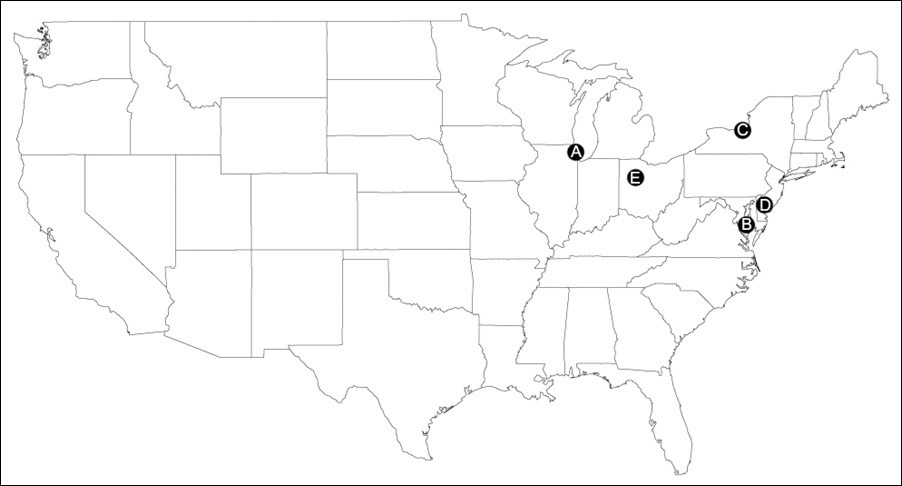
All of the shipyards built Liberty ships. The shipyards marked with a (V) also built Victory ships.
Questions for Map 1
1. Compare Map 1 with an atlas or a map of the United States map. Make a list of the states where the shipyards were located. On what bodies of water were the shipyards located?
2. What effect do you think climate might have on producing ships? Would having a large population nearby be important? If so, why? Why do you think most of the shipyards that built Victory ships were located on the West Coast, and especially in California? Which shipyard on the East Coast built Victory Ships?
3. Why do you think it would be important to have shipyards along the East, West, and Gulf coasts, and not just in one area?
Map 2: North Atlantic Ocean.
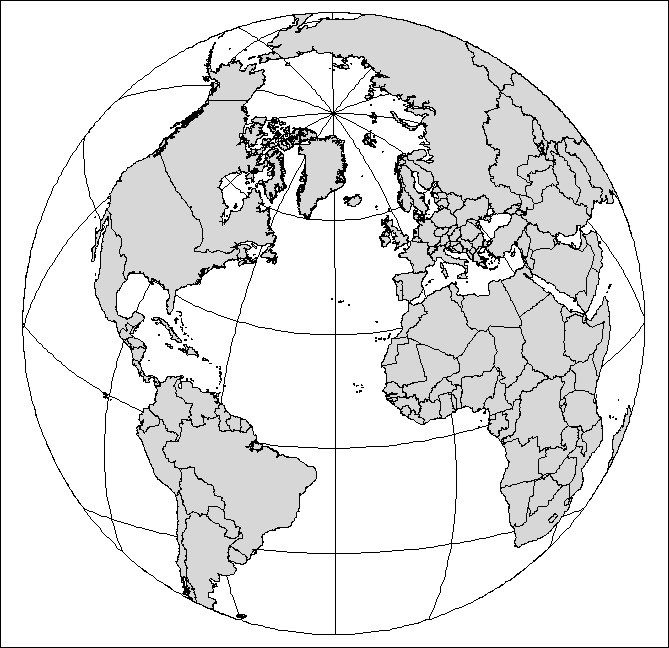
Questions for Map 2
1. Using an atlas, world map or globe, locate the Atlantic Ocean, North America, South America, Europe, Africa, Greenland, Iceland, Germany and Great Britain. Mark them on Map 2.
2. Using an atlas or a United States map, locate New York City. Mark it on Map 2.
3. On Map 2, draw a line between New York City and Great Britain. This would be the most direct route between the two and a logical shipping lane. However, German submarines patrolled these shipping lanes. Try to determine other routes to get the supplies from New York City to Great Britain and chart them on Map 2. What might be the difficulties of traveling to the north to reach Great Britain? What might be the difficulties of traveling to the south?
Determining the Facts Reading 1: Liberty Ships
When war broke out Europe in September 1939, the merchant fleet was caught unprepared to handle a massive sealift of war material. With continental Europe under German control, and Great Britain under devastating air attack, President Franklin Roosevelt decided to increase the pace of production to provide ships to America's British allies. The result was the emergency fleet program, which introduced the assembly-line production of standardized ships--the Liberty ships--in 1941. The Liberty ship represented the design solution that would fill the need for an emergency type of simple, standardized cargo steamer. Based on a British design, it could be mass-produced cheaply and quickly using assembly-line methods and could easily be converted to individual military service needs. The United States designated this new type of ship the EC2 (E for emergency, C for cargo and 2 for a medium-sized ship between 400 and 450 feet at the waterline.) Production speed grew more important as German submarines sank ships trying to break Hitler's naval blockade of Great Britain. The Allies needed ships by the hundreds to replace these losses and to increase the flow of supplies to England and, later, the Soviet Union. The first of these new ships was launched on September 27, 1941. It was named the SS Patrick Henry after the American Revolutionary War patriot who had famously declared, "Give me liberty, or give me death." Consequently, all the EC2 type of emergency cargo ships came to be known as Liberty ships. Naming nearly 3,000 ships turned out to be harder than people thought. Unlike the later Victory ships, there was no plan for how the Liberty ships would be named. In the end, the Liberties were named for people from all walks of life. Ships were named after patriots and heroes of the Revolutionary War. They were named after famous politicians (Abraham Lincoln to Simon Bolivar), scientists (George Washington Carver to Alexander Graham Bell), artists (Gilbert Stuart to Gutzon Borglum who sculpted Mt. Rushmore) and explorers (Daniel Boone to Robert E. Peary). One ship was named the SS Stage Door Canteen after the famous U.S.O. club for military service members while another was named the SS U.S.O. in honor of the United Service Organization itself. The Liberty ships were slightly over 441 feet long and 57 feet wide. They used a 2,500 horsepower steam engine to push them through the water at 11 knots (approximately 12.5 miles per hour). The ships had a range of 17,000 miles. Liberty ships had five cargo holds, three forward of the engine room and two aft (in the rear portion of the ship). Each could carry 10,800 deadweight tons (the weight of cargo a ship can carry) or 4,380 net tons (the amount of space available for cargo and passengers). The crew quarters were located amidships (the middle portion of the ship). Many technological advances were made during the Liberty shipbuilding program. A steel cold-rolling process was developed to save steel in the making of lightweight cargo booms. Welding techniques also advanced sufficiently to produce the first all-welded ships. Prefabrication was perfected, with complete deckhouses, double-bottom sections, stern-frame assemblies and bow units speeding production of the ships. By 1944, the average time to build a ship was 42 days. In all, 2,751 Liberties were built between 1941 and 1945, making them the largest class of ships built worldwide. Each Liberty ship carried a crew of between 38 and 62 civilian merchant sailors, and 21 to 40 naval personnel to operate defensive guns and communications equipment. The Merchant Marine served in World War II as a Military Auxiliary. Of the nearly quarter million volunteer merchant mariners who served during World War II, over 9,000 died. Merchant sailors suffered a greater percentage of fatalities (3.9%) than any branch of the armed forces. The Liberty ship was considered a "five-year vessel" (an expendable, if necessary, material of war) because it was not able to compete with non-emergency vessels in speed, equipment and general serviceability. However, Liberties ended up doing well, plodding the seas for nearly 20 years after the end of World War II. Many Liberties were placed in the reserve fleet and several supported the Korean War. Other Liberties were sold off to shipping companies, where they formed the backbone of postwar merchant fleets whose commerce generated income to build the new ships of the 1950s and 1960s. However, age took its toll and by the mid-1960s the Liberties became too expensive to operate and were sold for scrap, their metal recycled. The first Liberty built, the Patrick Henry, was sent to the ship breakers (scrap yard) in October 1958. Of the nearly 3,000 Liberty ships built, 200 were lost during World War II to enemy action, weather and accidents. Only two are still operational today, the SS Jeremiah O'Brien and the SS John W. Brown. Questions for Reading 1 1. What is the U.S. Merchant Marine? What was the 1936 Merchant Marine Act? If needed, refer to Setting the Stage. 2. Why did the United States want to build merchant ships? 3. How many total ships did the Merchant Marine Act call for? 4. Why were the ships known as Liberty ships? How were the individual ships named? 5. Why were so many Liberty ships built? 6. What purpose did the ships serve during the war? What purpose did they serve after the war? Reading 1 was compiled from John Gorley Bunker, Liberty Ships: The Ugly Ducklings of World War II (Annapolis, Maryland: Naval Institute Press, 1972); Harry Butowsky, "SS Jeremiah O'Brien " (San Francisco County, California) National Register of Historic Places Inventory - Nomination Form (Washington, D.C.: Department of the Interior, National Park Service, 1985); James P. Delgado, "Lane Victory" (Los Angeles County, California) National Historic Landmark Nomination Form (Washington D.C.: Department of the Interior, National Park Service, 1990); Curtis P. Junker, revised by Peter E. Kurtze, "SS John W. Brown " (Baltimore City, Maryland) National Register of Historic Places Registration Form (Washington, D.C.: Department of the Interior, National Park Service, 1996); Samuel Eliot Morison, History of the United States Naval Operations in World War II. Vol. 1, The Battle of the Atlantic, September 1939-May 1943 (Boston: Little, Brown and Company, 1950); and L.W. Sawyer and W.H. Mitchell, The Liberty Ships: The History of the 'Emergency' Type Cargo Ships Constructed in the United States During World War II (Cambridge, Maryland: Cornell Maritime Press, 1970).
Determining the Facts Reading 2: Victory Ships
In 1943, the U.S. Maritime Commission embarked on a program to design new types of emergency fleet ships, most importantly fast cargo vessels, to replace the slower Liberty ships. The standardized design adopted by the Commission called for a ship 445 feet long by 63 feet wide and made of steel. On April 28, 1943, the new ships were given the name "Victory" and designated the VC2 type (V for Victory type, C for cargo, and 2 for a medium sized ship between 400 and 450 feet long at the waterline). The Victory ships ultimately were slightly over 455 feet long and 62 feet wide. Like the Liberty ships, each had five cargo holds, three forward and two aft. The Victories could carry 10,850 deadweight tons (the weight of cargo a ship can carry) or 4,555 net tons (the amount of space available for cargo and passengers), a larger load than the Liberties could manage. Victory ships typically carried a crew of 62 civilian merchant sailors and 28 naval personnel to operate defensive guns and communications equipment. The crew quarters were located amidships. The Victory ships were different from the Liberty ships primarily in propulsion, the steam engine of the Liberty giving way to the more modern, faster steam turbine. The Victory ships had engines producing between 5,500 to 8,500 horsepower. Their cruising speed was 15-17 knots (approximately 18.5 miles per hour). The ship profile and the construction techniques of the Victories were also different from the Liberties. One important feature of the Victory ship was in the internal design of the hull, the ship's framework. The Liberty ships had the frames inside the hull set 30 inches apart. This made the hull very rigid. This rigidity caused the hull to fracture in some of the ships. The Victory ships had their hull frames set 36 inches apart. Because the hull could flex, there was less danger of fracture. The first Victory ship completed was the SS United Victory (built at Oregon Shipbuilding, Portland, OR), launched on January 12, 1944 and delivered February 28. The next 33 ships were named after member countries of the United Nations (e.g., SS Brazil Victory and SS U.S.S.R. Victory [both built by California Shipbuilding Corporation, Los Angeles, CA], and SS Haiti Victory [built by Permanente Metals Corporation, yard 1, Richmond, CA]). The ships that followed were named for cities and towns in the United States (e.g., SS Ames Victory [built by Oregon Shipbuilding], SS Las Vegas Victory [built by Permanente Metals Corporation, yard 1] and SS Zanesville Victory [built by Bethlehem-Fairfield Shipyards, Inc., Baltimore, MD]) and for American colleges and universities (e.g., SS Adelphi Victory and SS Yale Victory [both built by Permanente Metals Corporation, yard 2]). All of the ships' names ended with the suffix "Victory" with the exception of the 117 Victory Attack Transports that were named after state counties. The Maritime Commission built 414 Victory cargo ships and 117 Victory attack transports for a total of 531 vessels during the course of the war. Victory ships formed a critical maritime link to the theaters of war. These fast, large capacity carriers served honorably in both the Atlantic and Pacific theaters of war. Ninety-seven of the Victories were fitted out as troop carriers; the others carried food, fuel, ammunition, material and supplies. At the war's end a number of Victory ships were offered for sale by the Maritime Commission. One hundred and seventy were sold, 20 were loaned to the U.S. Army and the rest were stored as part of the reserve fleet. When the Navy no longer needs to use a ship but wishes to reserve it for a future emergency, it tows the ship to storage harbors, empties it of all fuel and cargo, and seals its windows and doors. The ship is protected from salt-water corrosion by a cathodic protection system and the interior spaces are dehumidified. This technique is called "mothballing," because it echoes how people preserve a wool sweater that is put away for the summer. Some vessels were reactivated to serve during times of national crisis, including the Korean War, the Suez Canal closure of 1956 and the Vietnam War. Other vessels were retained as logistic support ships as part of the Military Sealift Command, which in 1970 became the single managing agency for the Department of Defense's ocean transportation needs. The command assumed responsibility for providing sealift and ocean transportation for all military services as well as for other government agencies. In 1959, eight Victory ships were reclassified and refitted as instrumentation, telemetry, and recovery ships for the National Aeronautics and Space Administration (NASA) in support of America's space program. On August 11, 1960, the former SS Haiti Victory (renamed the USNS Haiti Victory (T-AK-238)) recovered the nose cone of the satellite Discoverer XIII, the first man-made object recovered from space. Over the years, many ships in the reserve fleet have been sold for scrap, their metal to be recycled. Of the thousands of Liberty ships and Victory ships produced only a small number remain. Questions for Reading 2 1. When and why did the Maritime Commission start a new program to replace the Liberty ships? 2. How were the Victory ships different from Liberty ships? 3. How were the Victory ships named? 4. What is "mothballing"? 5. Describe the ways the Victory ships were used after World War II. 6. Why are there so few Liberty and Victory ships today?
Determining the Facts Reading 3: Selected Ships' Histories
As the years went by, age took its toll on the Liberty and Victory ships. Many ships became too expensive to operate; insurance companies did not want to cover these old merchant ships. In most cases, they were sold for scrap. The reserve fleet was also being sold for scrap. What was once a proud fleet was now down to a precious few vessels. Some historic preservation and veterans organizations became interested in these ships and a handful were saved from the ship breakers. The following are the histories of five of these ships that have been preserved as floating museums to honor their service to the United States and to honor the mariners who sailed upon them. The Liberty Ship SS Jeremiah O'Brien The SS Jeremiah O'Brien is a World War II cargo ship and the product of a standardized design. The ship was named for Jeremiah O'Brien, a Revolutionary War hero who lived in Machias, Maine. In 1775, O'Brien led other residents of Machias in the capture of two British merchant ships. Using these captured ships, O'Brien captured the British armed schooner HMS Margaretta. This was the first naval action of the American Revolution. The keel (the bottom beam or plate juncture that runs the length of a ship) for the SS Jeremiah O'Brien was laid at the New England Shipbuilding Corporation, in South Portland, Maine on May 6, 1943. She was launched on June 19, 1943. The ship was owned by the federal government and operated by Grace Line, Inc. For the next year, the ship carried ammunition and grain, as well as other dry cargo. In June 1944, the Jeremiah O'Brien supported the D-Day invasions by ferrying supplies between Great Britain and Normandy, France 11 times. After the war, plans were made to transfer the ship to the U.S. Army for conversion to a hospital ship. The conversion never occurred and the ship was "mothballed" at the reserve fleet near San Francisco. In 1966, the U.S. Maritime Administration wanted to preserve a Liberty ship and chose the Jeremiah O'Brien. The ship was designated a National Historic Landmark (NHL) in 1986. NHLs are nationally significant historic places designated by the Secretary of the Interior because they illustrate the heritage of the United States. Over the years, the ship was restored and is now a museum in San Francisco, CA. She is only one of two Liberty ships still operational. The ship participated in the 50th anniversary of the D-day landings in 1994. The Liberty Ship SS John W. Brown The SS John W. Brown is a World War II cargo ship built by the U.S. Maritime Commission. In 1942, she was built in 41 days at the Bethlehem-Fairfield Shipyard in Baltimore, Maryland. She was launched on Labor Day, September 7, 1942. The ship was named after an American labor leader who organized workers in shipyards. After being launched, the ship sailed to New York and departed on its maiden voyage on September 29, 1942 carrying supplies to the Middle East. In 1943, the ship was converted to carry troops as well as cargo. Later, the John W. Brown supported combat operations in the Mediterranean Sea. The ship was involved in the Allied landings at Sicily and Anzio in Italy, and southern France. After the war ended in Europe, the John W. Brown carried U.S. military personnel home. In 1947, the Maritime Commission loaned the ship to New York City to use as a training vessel for high school students interested in maritime jobs. However, it became too expensive to run the school, and the ship was returned to the Maritime Commission and put into storage with the reserve fleet on the James River in Virginia. Historic preservation groups, including Project Liberty Ship and the Baltimore Museum of History (MD), wanted to protect the ship and it was transferred to them to turn into a museum in Baltimore, MD. She is one of only two Liberty ships still operational. The Victory Ship SS American Victory The SS American Victory was launched on June 20, 1945 at the California Shipbuilding Corporation yards in Los Angeles, California. The ship was named after American University in Washington, D.C. in honor of the school's contribution to war training and weapons research in both World War I and World War II. The ship's first voyage was in July 1945 carrying military supplies to Manila, Philippines. After the war, the ship was used by the American Export Lines carrying cargo in support of the Marshall Plan, a U.S. economic diplomacy plan to help rebuild Western Europe after the war. On one of its many voyages, the American Victory was caught by ice in Odessa, Russia. Rather than wait for an ice breaker to clear the shipping lanes, the captain of the American Victory used her to break the ice! In 1947, the American Victory was put into the reserve fleet. In 1952, the ship was brought out of "mothballs" to carry military supplies in support of the Korean conflict. After the Korean War, she was again sent to the reserve fleet. In 1963, the Navy planned to convert 15 Victory ships, among them the American Victory, as forward depot ships. These ships would be loaded with supplies and ammunition and placed around the world to support American troops if needed. However, the Navy canceled the plan in 1966 and that same year, the American Victory was again brought out of "mothballs" to support the Vietnam War. She carried military vehicles, telephone poles, explosives, and bombs. In 1969, she was again put in the reserve fleet. In 1999, the American Victory was acquired by a preservation group and turned into a museum in Tampa, FL. The Victory Ship SS Lane Victory The SS Lane Victory was built by the California Shipbuilding Corporation in Los Angeles. She was launched on May 31, 1945. The ship was named for Lane College, which was established as a high school for black youths in 1882 by Isaac Lane, a bishop of the Methodist Episcopal Church at Jackson, Tennessee. The school grew into a prominent liberal arts college. On her first voyage, June 27, 1945, the ship carried supplies in the Pacific. She was operated by American President Lines. In 1950, the Lane Victory was used to evacuate Korean civilians and U.N. personnel at Wonsan, South Korea during the Korean War. The ship also saw duty during the Vietnam War. In 1970, the ship was placed in the reserve fleet. Because of her excellent condition, the Maritime Administration decided to set aside the Lane Victory for preservation. In 1988, the Lane Victory was acquired by the U.S. Merchant Marine Veterans of World War II and turned into a museum in San Pedro, CA. In 1990, the ship was designated a National Historic Landmark. The Victory Ship SS Red Oak Victory The SS Red Oak Victory was built by the Permanente Metals Corporation, Shipbuilding Division Yard 1 in Richmond, California, across the bay from San Francisco. Her keel was laid August 15, 1944 and she was launched November 9, 1944. She is one of the last ships built by the Richmond Shipyard during World War II. The ship was named after the community of Red Oak, Iowa, which suffered the highest per capita casualty rate of any American community during World War II. On December 5, 1944, she was commissioned as the USS Red Oak Victory (AK-235) for the the U.S. Navy to be used as an ammunition carrier. In January 1945, after sea trials, she loaded over 10,000 tons of ammunition from the Port Chicago Ammunition Depot, Concord, California and departed for Pearl Harbor, Hawaii. In February 1945, she steamed to a remote area of the South Pacific called Ulithi Atoll where the worlds largest formation of Allied forces had amassed for the invasion of Japan. From March to May 1945, the USS Red Oak Victory (AK-235) replenished numerous vessels of the Pacific fleet. From June to October 1945, she supported the liberation of the Philippine Islands. In November 1945, she headed home to Seattle, Washington were she was decommissioned on May 21, 1946 and returned back to the U.S. Maritime Commission. In May 1947, she was leased to the Luckenbach Gulf Steamship Company, Seattle, Washington. She made several voyages, most notably supporting the UN forces engaged in the Korean War with military cargo. From 1957 to 1965 she was in storage by the U.S. Maritime Commission. In December 1965, she was leased to the American Mail Lines and until December 1968, supported U.S. forces engaged in the Vietnam War. She was placed back into storage until September 1998, where she was obtained by the Richmond Museum Association to be restored back to her original operational launch condition. Today, the Red Oak Victory is an integral part of the Rosie the Riveter/World War II Home Front National Historical Park. Questions for Reading 3 1. What was some of the cargo these ships carried? 2. Looking at a world map or atlas, locate some of the places to which each of these ships carried cargo. Does this give you a better appreciation for the mission of the seamen who served in the Merchant Marine? Why or why not? 3. Unlike the Liberty ships, which were built to be expendable, the Victory ships were designed to last for at least 20 years after being built. What examples can you find in the reading to support this? 4. Of the thousands of Liberty and Victory ships built, only a few remain. Why do you think it is important to preserve these ships? Reading 3 was compiled from John Gorley Bunker, Liberty Ships: The Ugly Ducklings of World War II (Annapolis, Maryland: Naval Institute Press, 1972); Harry Butowsky, "SS Jeremiah O'Brien " (San Francisco County, California) National Register of Historic Places Inventory - Nomination Form (Washington, DC: Department of the Interior, National Park Service, 1985); James P. Delgado, "Lane Victory" (Los Angeles County, California) National Historic Landmark Nomination Form (Washington DC: Department of the Interior, National Park Service, 1990); Curtis P. Junker, revised by Peter E. Kurtze, "SS John W. Brown " (Baltimore City, Maryland) National Register of Historic Places Registration Form (Washington, DC: Department of the Interior, National Park Service, 1996); Shelby Sampson, "SS Red Oak Victory " (Contra Costa County, California) National Register of Historic Places Registration Form (Washington, DC: Department of the Interior, National Park Service, 2000); L.A. Sawyer and W.H. Mitchell, Victory Ships and Tankers (Newton Abbot, England: David and Charles Publishers, 1974); and Timothy J. Teahan and Barbara E. Mattick, "SS American Victory " (Hillsborough County, Florida) National Register of Historic Places Registration Form (Washington, DC: Department of the Interior, National Park Service, 2001).
Visual Evidence
Photo 1: "your merchant marine has grown.".
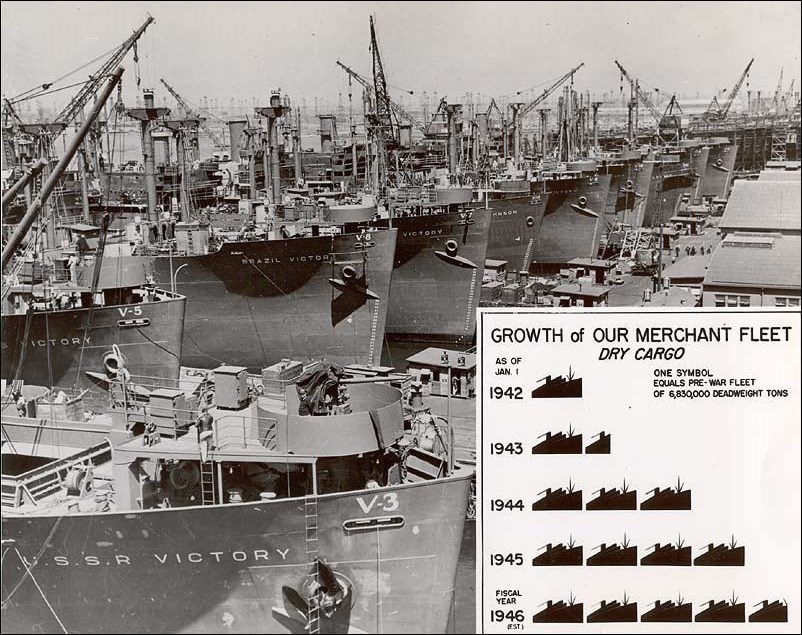
(Courtesy U.S. Maritime Administration) Press release from the War Shipping Administration, May 20, 1945.
War Shipping Administration Washington, D.C.
News Foto Release No. 76, (#2 of 5). For Release May 20, 1945.
Your Merchant Marine Has Grown
American merchant shipyards have built four ships for every prewar ship we had. Our fleet of Liberty, Victory, C-type and other vessels reached an all-time high of more than 3,500 dry cargo vessels, and more than 900 high-speed tankers. This huge fleet, in 1944, moved out of the United States more than 72 percent of 78,500,000 tons of cargo shipped. Three percent were carried by the U.S. armed forces and 24 percent by the combined tonnage of other United Nations. Transfer of troops and supplies from Europe to the far Pacific, over sea lanes ranging from 12,000 to 18,000 miles, will demand maximum efficiency in the use of our huge fleet under control of the War Shipping Administration and the United Nation's pool. --WSA photo 4235 (Courtesy U.S. Maritime Administration) Questions for Photo 1 1. A press release is a statement or an article that the government and other organizations give to newspapers to announce news and information. Why would the War Shipping Administration think it was important for newspapers to print this article and photograph? 2. Look at the chart in the above photograph. What statistical information does this chart present? By how much has the amount of cargo carried grown between 1942 and 1945? 3. How does this photograph of the shipyard help you in answering Question 2? Explain. 4. Photo 1 shows both Victory ships and Liberty ships under construction. Can you find the Liberty ship in Photo 1? What clues did you use to determine the difference between the Victory ships and Liberty ships?
Photo 2: "Salute Your Merchant Marine on Maritime Day--May
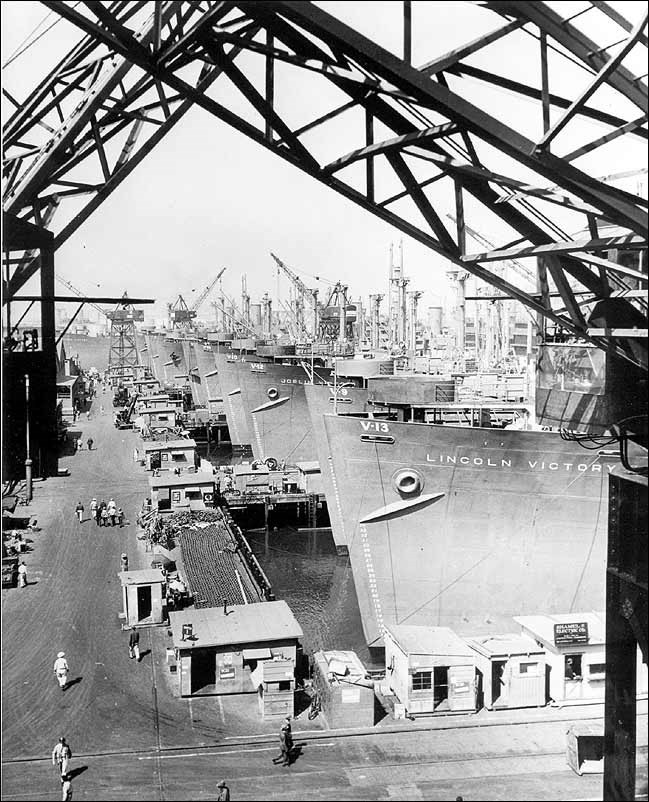
U.S. Maritime Commission Washington, D.C. News Foto Release No. 74, (#2 of 12) Watch Your Release Date - Not before May 13, 1945.
Salute Your Merchant Marine on Maritime Day--May 22
Not done with mirrors: Victory ships almost as far as the eye can reach line up at a West Coast shipyard for final outfitting before joining our vast merchant fleet. On Maritime Day, May 22, we shall have nearly 300 of these crack cargo type in service, and 300 more will be delivered before the year is out. --Maritime Commission photo 4236 (Courtesy U.S. Maritime Administration) Questions for Photo 2 1. This photo and caption was sent to local newspapers by the Maritime Commission to announce the upcoming Maritime Day. What do you think Maritime Day was about? Would Maritime Day be something worth celebrating? Explain. 2. What artistic elements did the photographer include in this Photo 2? 3. On the docks in front of the ships are lengths of chain. How might the chain be used on these ships?
Photo 3: North Atlantic Convoy, 1941.
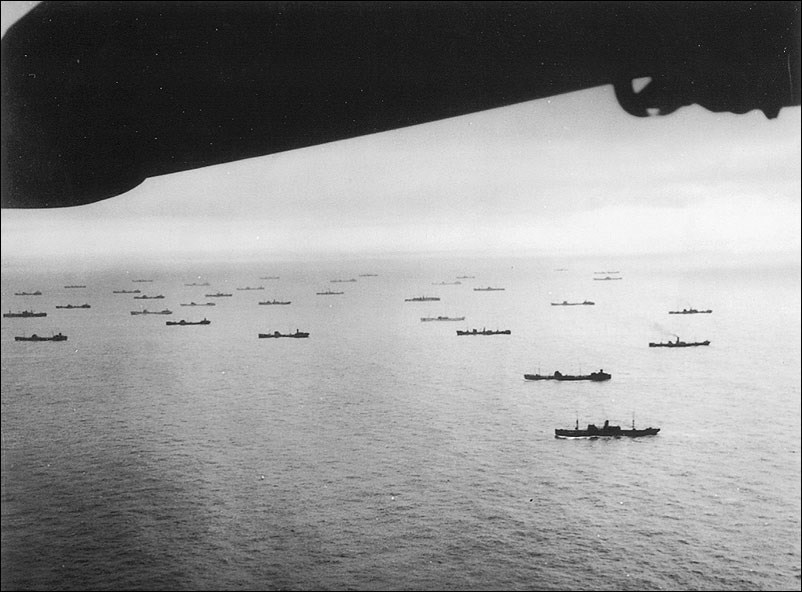
Photo 3 shows a convoy of ships in the North Atlantic. Some of the ships in the convoy are Liberty ships. In 1941, The United States established the forward military base in Argentia, Newfoundland to support convoy escorts and patrol aircraft. The photograph was taken from an airplane assigned to the USS Albemarle (AV-5), a seaplane tender (a ship built to house and support seaplanes), in October 1941. At the time the photo was made, the Albemarle was based at Argentia. In the early years of World War II, German submarines, also known as U-Boats, threatened ships traveling across the Atlantic Ocean. Many cargo ships were sunk by the U-Boats. The United States and the Allies developed many ways to protect ships carrying supplies to Great Britain and the Soviet Union. Some of the many innovations that came out of World War II to locate submarines include radar, sonar, and high frequency direction finding. Because ships traveling alone were almost certain targets for submarines, the U.S. and her Allies grouped the ships together in huge convoys. The Navy and Coast Guard escorted the convoys with destroyers. Unlike modern submarines, which can stay submerged for months at a time, the submarines in World War II spent most of their time on the surface and submerged only when attacking ships or evading detection. In areas that were close to land, airplanes were used to scout for submarines. Many of these scouting planes also carried bombs so they could attack detected enemy submarines. Questions for Photo 3 1. Using an atlas, locate Newfoundland, Canada. Look at Map 2. Where is Newfoundland located, in relationship to the line between New York and Great Britain? Why did it make sense to base convoy escorts and patrol aircraft, such as the seaplanes from the USS Albemarle, in Newfoundland? 2. Why would grouping ships together in convoys help protect ships from submarines? 3. Photo 3 shows part of the wing of the patrol aircraft. In what ways did the patrol aircraft help protect ships carrying supplies?
Illustration 1: U.S. Merchant Marine Commemorative Stamp.
This stamp was issued by the U.S. Post Office Department on February 26, 1946 to honor the achievement of the United States Merchant Marine in World War II. The stamp depicts a Liberty ship unloading cargo. Questions for Illustration 1 1. Look up the word "commemorate" in the dictionary. What does it mean? 2. What is a "merchant marine"? Why do you think it was important to honor the Merchant Marine with a postage stamp? 3. The words "Peace and War" are placed at the top of the stamp. Why do you think these words were put on the stamp? Why is the word "peace" placed first?
Photo 4: Liberty Ship, 1941.
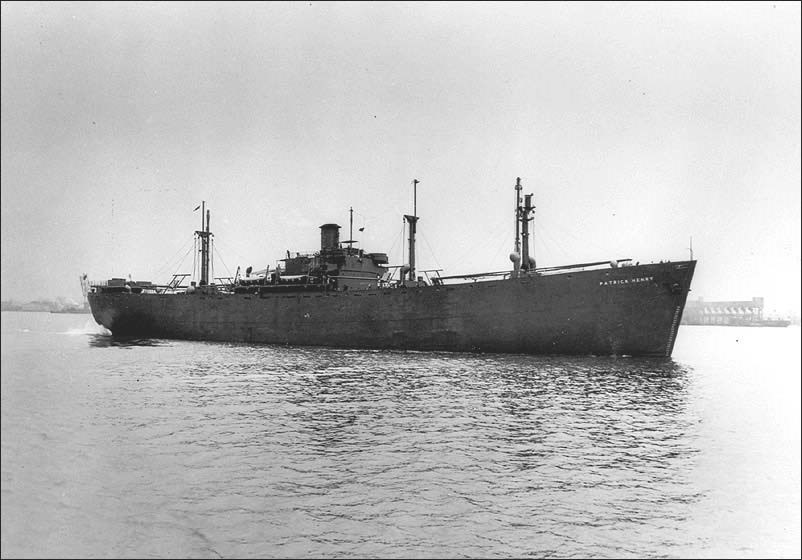
(Library of Congress) Photo 4 shows the first Liberty ship, SS Patrick Henry, shortly after its launch in September 1941. Questions for Photo 4 1. The ship was launched September 27, 1941. Considering the year it was built, what might be one reason why this Liberty ship doesn't have any weapons? If needed, refer to Setting the Stage. 2. Note the faint white markings on the bow of the ship. Those are numbers. What do you think the numbers are for? Based on your answer, can you determine if this ship is loaded or unloaded? How did you come to your conclusion? 3. The ship has three masts. What could they be used for? If needed, compare Photo 4 with Illustration 1.
Putting It All Together
The Liberty ships and Victory ships were built in order to move troops and supplies during World War II. They were built in great numbers to counter the threat from submarines and to ensure that the flow of men and material was unhindered. The following activities will help students discover more about Liberty and Victory ships and the role their community and its residents played during World War II. Activity 1: Pay Tribute to Local History Have students design a postage stamp depicting an important event that happened in your community. Encourage students to be creative with designs and color. Students should share their "stamps" in class and hold a class discussion on why they chose to commemorate that particular event. Activity 2: Serving the War Effort By using simple designs, perfecting mass-production techniques and building the necessary shipyards, the U.S. was able to produce the massive fleet of merchant ships needed to win World War II. However, there were not enough workers for all the new shipyards. Many men who could have built ships were serving in the armed forces. As a result of this labor shortage, many factories and shipyards hired women, minorities, and men unable to go to war to work on the assembly lines and in the shipyards to manufacture the products needed to prosecute the war. The women were given the nickname "Rosie the Riveter" after a worker in a popular song. Ask students to locate persons in the community or their families who worked in the farms, factories and shipyards during World War II. Students may find that local organizations that serve veterans and senior citizens are a good resource for locating these individuals in their communities. Organize a class project to participate in the Veterans History Project of the Library of Congress by interviewing these persons and donating the interviews to the Library of Congress. See the Library of Congress Veterans History Project website at [http://www.loc.gov/folklife/vets/], or write to The Veterans History Project, American Folklife Center, Library of Congress, 101 Independence Ave., SE, Washington, D.C. 20540 for more information. The project website offers sample interview questions for civilians who worked in support of the United States during the war. A free "Field Kit" is also available with tips for interviewing. You can download the kit for free on the project's website [http://www.loc.gov/vets/kitmenu.html]. Activity 3: Carrying the Supplies The Liberty ships and Victory ships carried many different types of important supplies in support of the war including food, fuel, vehicles, ammunition, and spare parts. Ask students to locate farms or factories in your community that supplied the war effort. Have them research how they supported the war. The local historical society or library's local history section is a good place for students to start their research. Students may need to look at old phone books, city directories, or newspapers to determine which businesses were active in their community during the war and whether they were involved in war production. Students should share the information they have discovered in the form of papers, project boards, computer slideshows, skits, or oral presentations.
Liberty Ships and Victory Ships, America's Lifeline in War-- Supplementary Resources
Liberty Ships and Victory Ships, America's Lifeline in War will help students in understanding how the United States mobilized a massive construction effort to build a large merchant fleet to serve in war and peace. Of the thousands of ships built during World War II, only a small number remain. Those interested in learning more will find that the Internet offers a variety of materials about the people, vessels, and organizations associated with this great accomplishment.
Rosie the Riveter/World War II Home Front National Historical Park Rosie the Riveter/World War II Home Front National Historical Park is operated as a partnership between the National Park Service, the City of Richmond, the Rosie the Riveter Trust and the Richmond Museum of History. The park opened in 2000 and is still in development. The park preserves and interprets the history of the men and women who worked at the factories and shipyards in and around Richmond, California in support of World War II. Among the many units of the park is the site of the Richmond Shipyard (which built many of the Liberty and Victory ships), the automotive plant (which produced military vehicles), the Rosie the Riveter Memorial, the Liberty Ship Memorial and the SS Red Oak Victory (a World War II era Victory ship). The SS Red Oak Victory is currently undergoing restoration, please check the website for updates.
United States Maritime Administration This agency under the Department of Transportation oversees the merchant marine of the United States. Visit their website , for more information on the merchant marine, including an Education page.
United States Merchant Marine Academy Visit the website of the school in Kings Point, New York, that trains future officers of the merchant marine. The site also contains links to the Maritime Museum, which includes artifacts and historic pictures.
Naval Historical Foundation A non-profit organization dedicated to preserving and promoting the Navy's proud heritage. The Foundation supports the activities of the Naval Historical Center. Their website has information on primary sources including oral histories, memoirs and personal paper collections.
U.S. Maritime Service Veterans Veterans of the merchant marine and U.S. Naval Armed Guard operate this extensive website . This is a comprehensive site about the history and traditions of the merchant marine. There are extensive histories of the merchant marine in World War II, the Korean War and the Vietnam War.
American Rosie the Riveter Association This is a national organization made up of the women who worked in the factories and shipyards during World War II. The website includes a newsletter and links to related sites.
Historic Naval Ship Visitors Guide This website , maintained by the Historic Naval Ships Association, is a worldwide listing of historic ships that are open to the public, including ships' histories and contact information.
NOVA: Hitler's Lost Sub The PBS series NOVA aired an episode on the discovery of a sunken German submarine off the coast of New Jersey. The website includes a history of this U-Boat, a virtual tour and a transcript of the show that includes a detailed account of the Battle of the Atlantic during the early years of World War II, when the submarine threat to shipping was at its height. The website also has a Teacher Resources page.
You Might Also Like
- liberty ships
- liberty ships and victory ships
- world war ii
- teaching with historic places
- national register of historic places
- nrhp listing
- california history
- maryland history
- florida history
- early 20th century
- u.s. in the world community
- military wartime history
- role of the us in the world community
- military history
7-14 October, 2024

- Center For Humanitarian Assistance
- STEM Center
- Career Fair
- Neighborhood Concert Series
- High School Band Challenge
- Honor Our Fallen Concert
- Humanitarian Assistance Village
- Parade of Ships
- Veterans Art Exhibit
- Concession Fundraising
- Visiting Ships & Tours
Conduct During Shipboard Tours
- Boat Safety
- Transportation
- The Center for Humanitarian Assistance
- Bay Area Military History
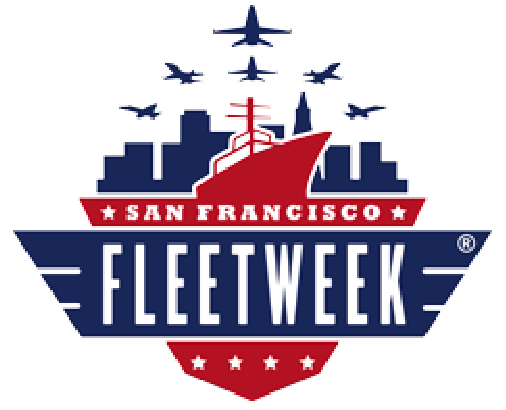
The public is encouraged to attend tours and interact with U.S. Navy, Marine Corps and Coast Guard personnel.
Report any suspicious activity immediately to military or police personnel
- Over 18 years of age must have a valid government-issued ID
- Those 17 years old and under must be accompanied by an adult.
- No large backpacks, oversized camera bags, or large purses
- No holding areas for personal items - backpacks, strollers, bicycles, scooters, pets, etc.
- All non-permitted items will not be allowed to remain on or near the pier areas. They will be removed from the pier and may be searched or otherwise disposed of.
- No pre-registration or RSVP is required
- Visitation to all participating vessels is on a first-come, first-served basis.
- Ship tours may not be appropriate for those with disabilities and access and functional needs or certain medical conditions. There are steep ladders (stairways) to climb and uneven surfaces to traverse on board the ship. An alternative experience will be provided on the pier for those who wish to learn more about the ships in Port.
- Open-toe shoes are not recommended. High heels are not permitted.
- Failure to consent to screening and inspection will result in denial of authorization to enter the property.
- All visitors will remain with the tour guide at all times and will not deviate from the dedicated tour route.
- Report any suspicious activity immediately to any military or police personnel.
Prohibited Items
All personnel is screened, and all bags are searched before entering the pier.
- Defensive chemicals or sprays, including mace, pepper spray, and aerosol spray cans
- Large backpacks, oversized camera bags, or large purses
- Smoking, dipping, or chewing gum while onboard USN Ships or within 100FT of watch-standers
- Illegal drugs and/or paraphernalia, including marijuana
- Food and drinks, including ice chests and coolers
- Pets ( including service animals )
- Guns, knives, clubs, or weapons of any kind
- Skateboards/bicycles/scooters
- Gang-related clothing
- Fireworks, flammable liquids, or other explosives

IMAGES
COMMENTS
We have several guides on this site to help you with information about planning your experience at Fleet Week under "Plan Your Trip". All ship tours are free of charge ... San Francisco Fleet Week Association P.O. Box 460880 San Francisco CA 94110 Email: ...
Come climb aboard the amphibious carriers, cutters, destroyers and cruisers docked at the Embarcadero and get a glimpse into the day-to-day lives of the sailors serving in the U.S. Navy, and the U.S. Coast Guard. Join us on the San Francisco waterfront to tour our visiting ships docked at the Port of San Francisco and get a glimpse of the day ...
San Francisco Fleet Week's Air Show, Parade of Ships, Ship Tours, Concerts, and many more community events honors the men and women of the United States Armed Forces. Skip to content. ... San Francisco Fleet Week succeeds with the support and participation of volunteers in all aspects of the show's production. Friendships are built and ...
Fleet Week San Francisco is an annual event that draws thousands of people into the city. It's a free event in the Fisherman's Wharf district that features the Blue Angels, a full air show over the SF Bay, and ship tours all weekend long. This year, Fleet Week is October 7 - 15, 2024. Most activities and the large air show are over the weekend ...
No tours, however, the ships can be seen in the San Francisco Fleet Week Parade of Ships 11-11:30 a.m. from Marina Green, Fort Mason, Aquatic Park, Fisherman's Wharf, Pier 39 and the Embarcadero ...
San Francisco Fleet Week. Head to the Port for San Francisco Fleet Week! From October 2- 10, 2023, visitors can watch the famous Fleet Week Air Show, Parade of Ships and climb aboard various military ships docked at the Embarcadero to get a glimpse into the day-to-day lives of the sailors serving in the US. Navy and the US Coast Guard.
San Francisco. One way to experience San Francisco Fleet Week is to climb aboard various ships docked in the Bay and see what it's like to be a sailor in the U.S. Navy or...
SAN FRANCISCO (KGO) -- The US Navy opened three ships to the public Wednesday morning in San Francisco for Fleet Week. The USS Monsoor and the USS Shoup are docked at Pier 35. The USS Rushmore is ...
From the Blue Angels to ship tours, here's what you need to know about San Francisco Fleet Week By Brendan Weber • Published September 23, 2022 • Updated on October 7, 2022 at 11:42 pm NBC ...
Eventbrite - San Francisco Maritime National Park Association presents Fleet Week: With A Waterfront Seat 2024 - Saturday, October 12, 2024 at USS Pampanito and the Triangle at Historic Pier 45, San Francisco, CA. Find event and ticket information.
Bring some cash to keep things moving and avoid any delays caused by often spotty WiFi on the Bay during the air show. Experience Fleet Week like never before with Red and White Fleet! Departure Time: 1:45pm. Pricing: $105 adults (ages 21+) $65 youth (5-20) 4 and Under Free. Cruise is approximately 2 hours and will return following the air show.
The 2023 festivities happen Oct. 2 through 10, running just after the Hardly Strictly Bluegrass Festival and concurrently with the Italian Heritage Festival. Article continues below this ad. The ...
The Blue and Gold Fleet has a two and ½ hour Blue Angels cruise during Fleet Week, $105 adults, seniors & military $85, $70 kids 5-11, under 5 free), including a box lunch from the Boudin Bakery. Alcohol and soft drinks are available for purchase. Saturday & Sunday, 1:30-4 pm, leaving from Pier 39.
Throughout the week guided ship tours will be offered, ... San Francisco Fleet Week Cruise on the SS Jeremiah O'Brien. Honor the contributions of men and women of the U.S. military as you cruise by the Golden Gate Bridge, Alcatraz and the Bay Bridge in a 1943 Liberty ship. Featuring waterfront-visiting Navy ships and air show views including ...
Ship Tours Wednesday October 6, 2021 Thursday October 7, 2021 Saturday October 9, 2021 Sunday October 10, 2021 10:00 AM - 4:00 PM Monday October 11, 2021. Skip to content. Facebook TikTok. Bay Area Military History; ... San Francisco Fleet Week Association P.O. Box 460880
In the four decades since its inception, San Francisco Fleet Week has become a model for similar celebrations around the country. ... Ship tours. Climb aboard destroyers, cruisers and amphibious carriers to peek into the life of sailors. 10 a.m.-4 p.m. Wednesday-Thursday, Oct. 6-7 and Saturday-Sunday Oct. 9-10; 9 a.m.-noon Monday, Oct. 11. ...
The parade begins at 11:00 a.m. on Friday of Fleet Week, October 11, 2024, with the first ship passing under the bridge, followed by the remaining ships.. The procession usually continues for an hour or two. Best Places to Watch. There is a good view of the ships anywhere along the waterfront from the bridge itself to the Ferry Building at the end of Market Street.
Air Show: Dates: October 11-13, 2024. Each year, the breathtaking SF Fleet Week Air Show, presented by United, captivates audiences near the Golden Gate Bridge and Alcatraz. This iconic waterfront event features the exhilarating performances of the U.S. Navy Blue Angels and stands out as the only air show in the country where a commercial ...
Parade of Ships. Watch each of the Fleet Week ships sail under the Golden Gate Bridge. 11 a.m.-noon. Oct. 11. Free. The Blue Angels on Oct. 5, 2017, seen from the Fairmont Hotel in San Francisco. The U.S. Navy Blue Angels practiced their aerial maneuvers and patterns for their upcoming Fleet Week airshow. Photo: Santiago Mejia / The Chronicle
Almost all the Fleet Week San Francisco activities are held along the waterfront district of Fisherman's Wharf. Keep in mind all ship tours are free and the Navy vessels will be open to the public. On Friday, October 11, 2024, there will be a Parade of Ships, which is a variety of United States Navy ships sailing under the Golden Gate Bridge ...
No tours however the ships can be seen in the San Francisco Fleet Week Parade of Ships 10:30am-11:30 p.m. from Marina Green, Fort Mason, Aquatic Park, Fisherman's Wharf, Pier 39 and the Embarcadero.
The San Francisco Fire Department will lead the parade with their fire boat shooting jets of water into the air to celebrate the Fleet's arrival. Contact Us. San Francisco Fleet Week Association. P.O. Box 460880. San Francisco CA 94110. Email: [email protected]. Air Show Inquiries: [email protected].
The ship is open seven days a week from 10:00 a.m. to 4:00 p.m. except when there is severe weather. ... The conversion never occurred and the ship was "mothballed" at the reserve fleet near San Francisco. In 1966, the U.S. Maritime Administration wanted to preserve a Liberty ship and chose the Jeremiah O'Brien. ... a virtual tour and a ...
Conduct During Shipboard Tours. The public is encouraged to attend tours and interact with U.S. Navy, Marine Corps and Coast Guard personnel. Report any suspicious activity immediately to military or police personnel. Those 17 years old and under must be accompanied by an adult. All non-permitted items will not be allowed to remain on or near ...